Birding at Namdapha & Maguri Beel
- With JungleHike Tours
- Jan, 2023

Namdapha Forest Camp Trail
Once again we started our journey early (since we stayed here only for 1 night, there were no issues with bag-packing). Unfortunately here we could not get our morning tea (it was too early for the hotel staff).
Today we were going into the Namdapha National Park. This place is famous for the butterflies (favorite location for all butterfly lovers) but that season is Oct-Nov and we were here in late January. For birding, not many people come here. Even for Avinash (our tour-lead and birding expert), this was the first visit.
Oh, I missed mentioning one thing. This region (Walong as well as Namdapha) has a good production of local oranges and during those 4-5 days, we just gorged on those juicy fruits. They were available cheaply and were being sold at many places on the road. So for every breakfast, and snack time (plus anytime we felt like it) oranges were there.
The park had an entry gate and we could enter inside without getting out of the vehicle (just our local guide Palash stepped out and completed the required formalities). We were going to stay inside the forest (Forest Guest House) for the next 2 nights, so our vehicles (and luggage) were allowed.
Although we were going to be at the Forest guest house, we were to reach there only by evening and hence had to carry our breakfast, as well as lunch with us. Inside the jungle, there is absolutely no possibility of getting anything (not even drinking water). So before entering the gates, we got the lunch provisions (rice preparation, daal, and pickles – oh, veg options only) from the village (all their utensils, and spoons were returned after 2 days when we returned).
After entering the gates, for the first few kilometers, we could see some villages across the river (once again we had the river for company… but instead of Lohit, this was Noa-Dibang river) but after that, it was only the jungle and the road here was too bad. This particular road was a long 150 km stretch up to Vijay nagar town (which was on the Myanmar border). Possibly the last town from India's side. I just shudder at the thought that someone has to travel on such a road for that long (using whatever vehicle that is).
From the photography point of view, if we thought Walong was difficult, then this was likely to be even more so. The trees were taller here and had much denser foliage. Look at the picture below to get some idea.
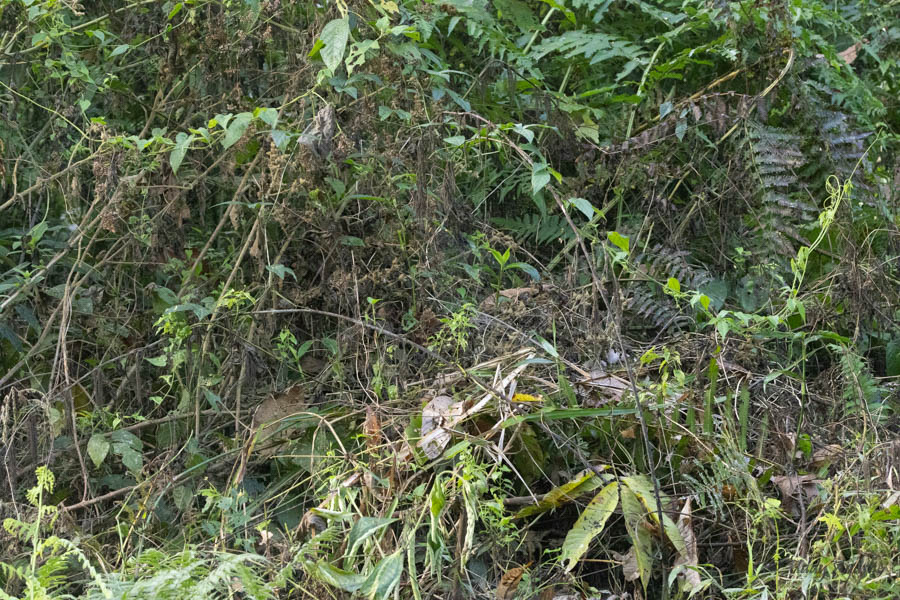
Soon as we entered the dense part, Palash stopped us. He had heard the beautiful Rufous-throated Fulvetta. A shy, skulker, this bird had given us a difficult time even in Mishmi. After getting down, we all lined up on one side of the road and waited for the bird to make an appearance somewhere near us.
I do want to mention one thing here (ethical, or non-ethical is up to the reader). The birds in Arunacahal have been subjected to hunting for generations and that makes them very shy. If we wait for the birds to come out in the open, then that is unlikely. So most birders resort to playing the recorded bird calls, to attract the birds. There is still no guarantee that the birds will come out, but this just increases the possibility. And at times, even we had to play the calls.
Coming back to the Fulvetta, we waited for 15+ minutes to finally get a glimpse of the bird. To me, any photo of this bird is a good photo (cannot apply the usual parameters to decide what is good). And frankly, not just this bird but many other small birds in this region fall under the same category.
Just as we were getting back into our vehicles, Avinash showed us the pigeons (Pin-tailed and Wedge-tailed Green Pigeons)
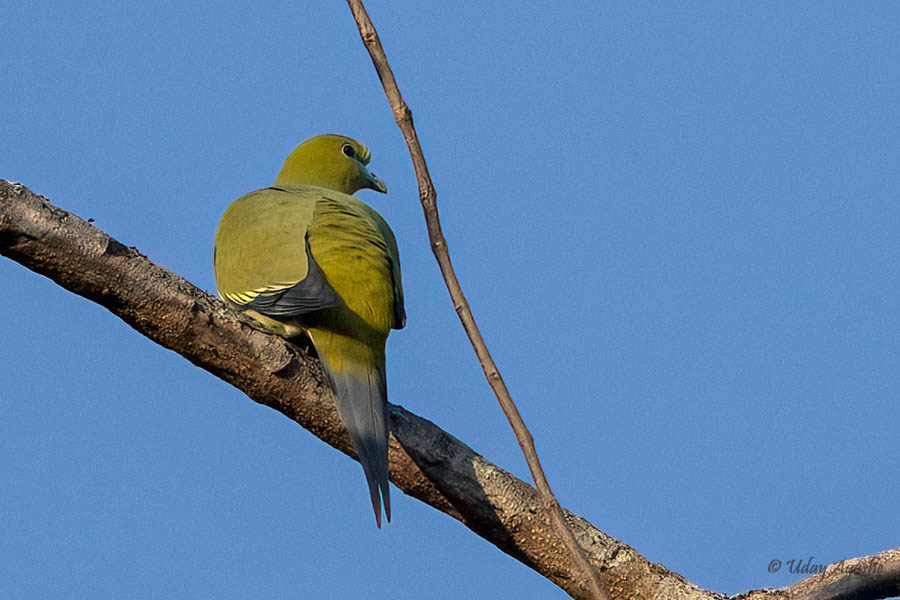

We moved ahead by a few 100 meters and stopped again. This time, on the tall trees we could see/hear a lot of bird activity. Oh and here, we could see one raptor too. There was some confusion about its identity as it was on top of a tall tree. Looking at zoomed pictures, it turned out to be the Shaheen Falcon (resident morph of the Peregrine Falcon). As we were watching thru binoculars, some reddish bird flew from one end to the other. Briefly perched on the bark (must be either woodpecker, nuthatch, or some creeper) and went in the deep cover. Thankfully, I was able to capture this Bay Woodpecker in camera (poor quality photo though). We spent considerable time at that spot as there were so many birds around. We could identify the Ashy Bulbuls (and Black-crested, Red-vented bulbuls), Barbets, Babblers, White-bellied Erpornis, Rufous-faced Warblers, Maroon Oriole, and Drongos. We even saw the Oriental Hobby as it sped across us (flew so fast, we could not even take out our cameras in time).
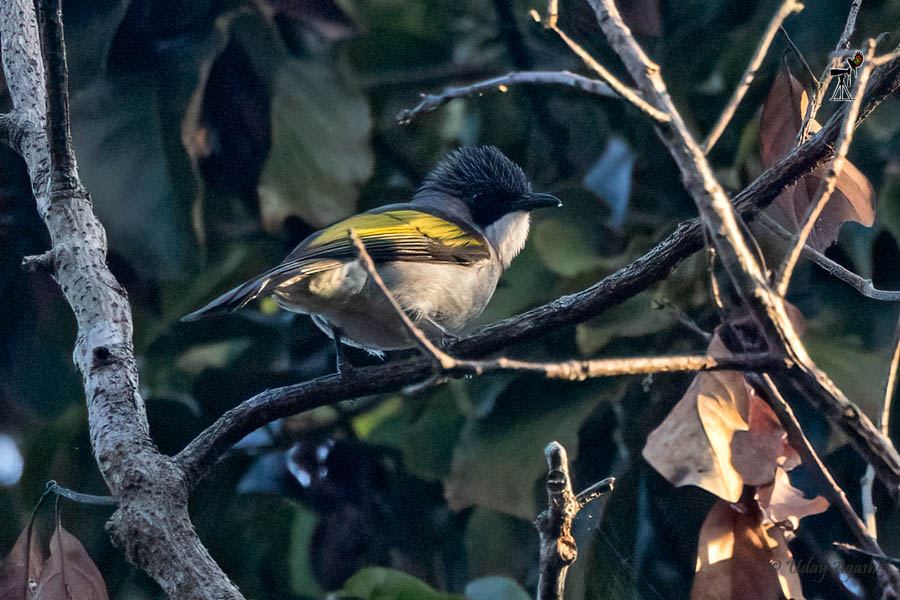
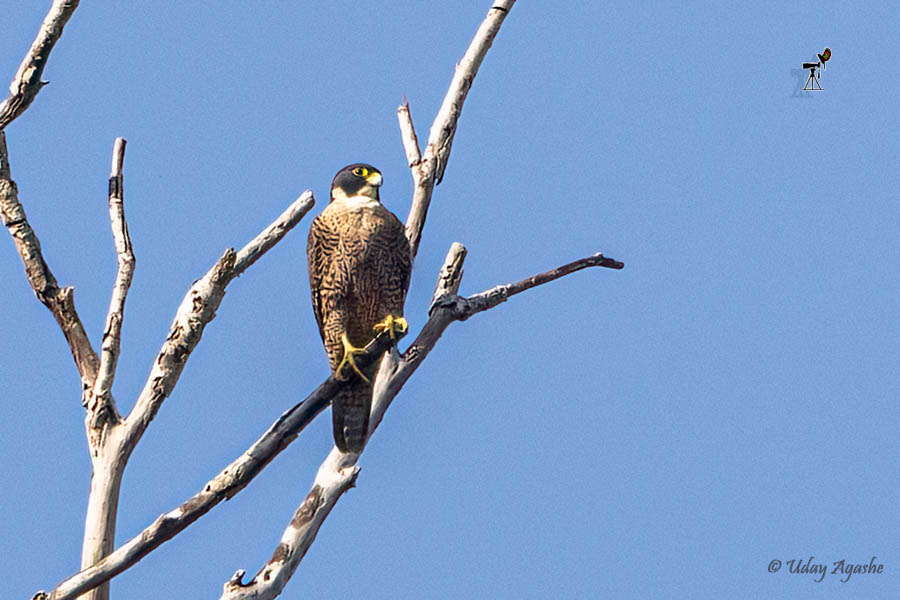
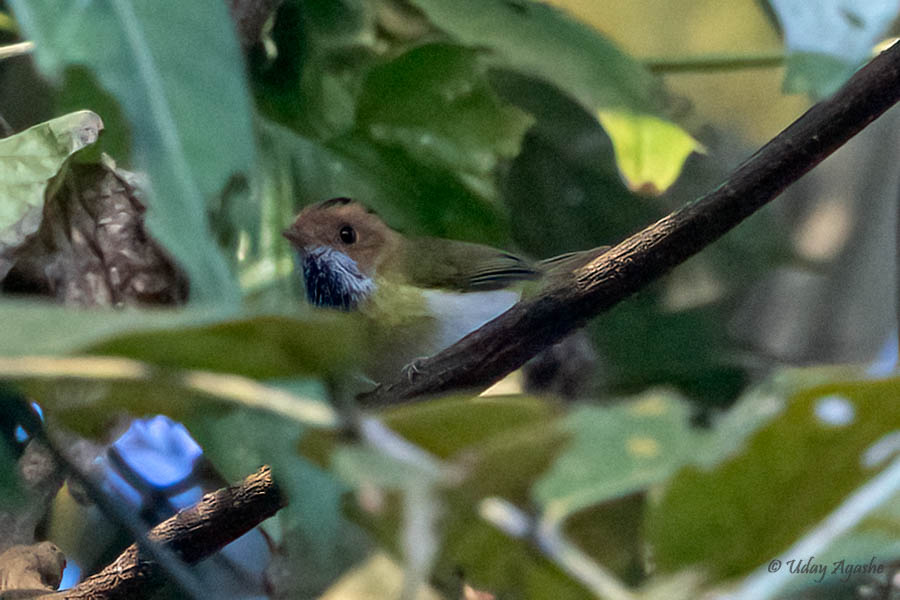
We ended up spending so much time at this spot that we decided to have our breakfast. Here we could also see a couple of butterflies but not the exotic ones that I had heard so much about (Namdapha specials).
We continued our walking trail for some more distance. This part of the jungle was dense but there definitely was a lot of bird activity around. So we kept finding the Large Woodshrikes, Bar-winged Flycatcher shrikes, and lots of minivets. This time I was able to take a photo of the white-bellied Erpornis as well. And as we were busy with birds, we noticed a large squirrel. It was the Malayan Giant Squirrel.
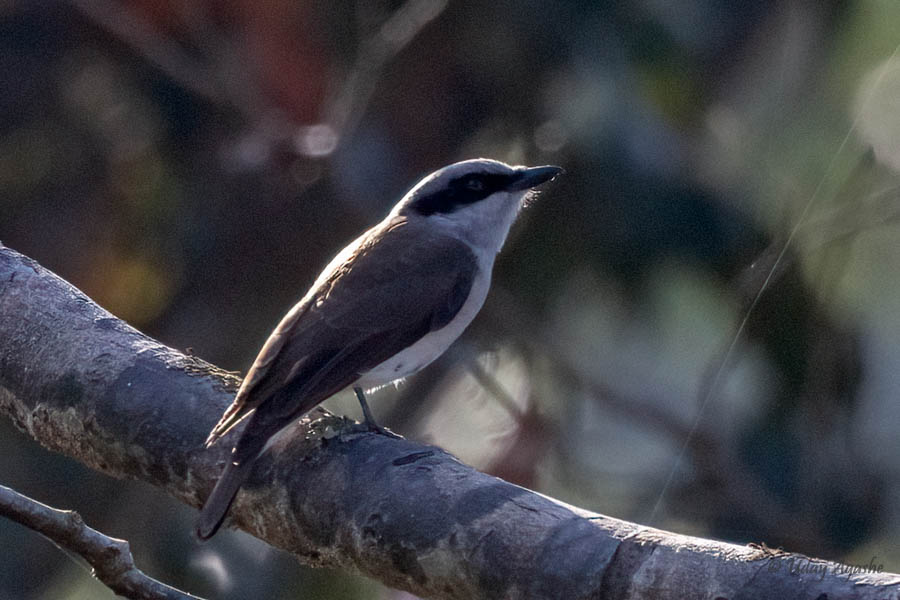
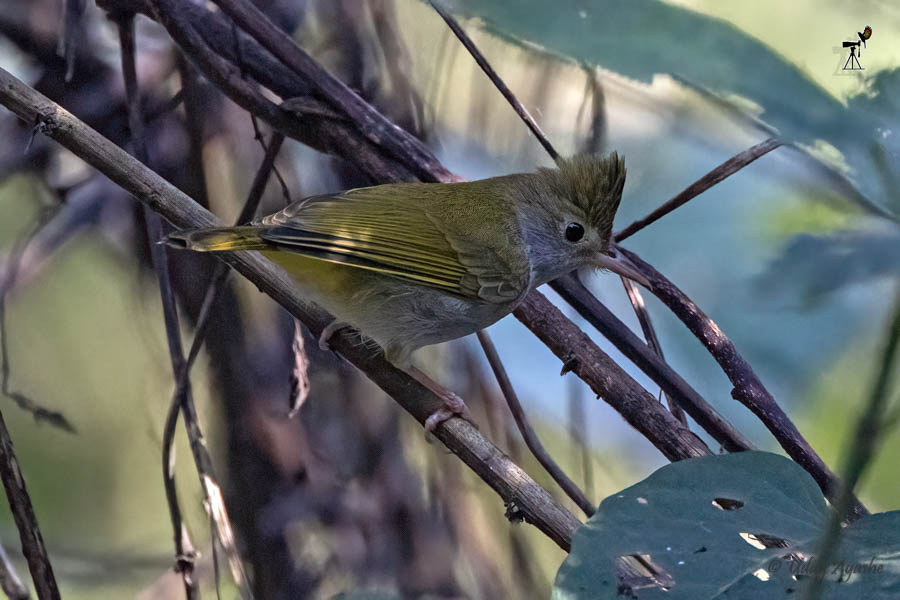
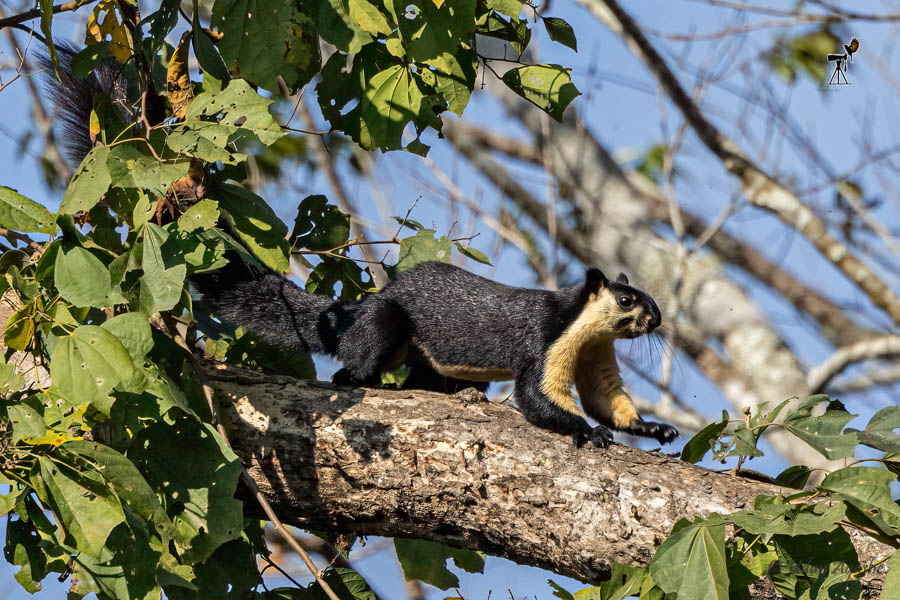
We kept finding more and more birds on the trail but among them, with the Collared Treepie, we spent a lot of time. Not that it was near or photogenic but just that we had a tough time finding it in the dense trees. Palash spotted it first and then Avinash/Clara. After that, he took a lot of pains in explaining to us the exact location (even with the help of the laser pointer torch). I tried moving a few meters here and there but was not able to locate it at all. It is not a small bird as such, but still, it took a lot of time for me to finally see it! Once seen, I was able to take a photo as well.
Here we also saw some uncommon butterflies.
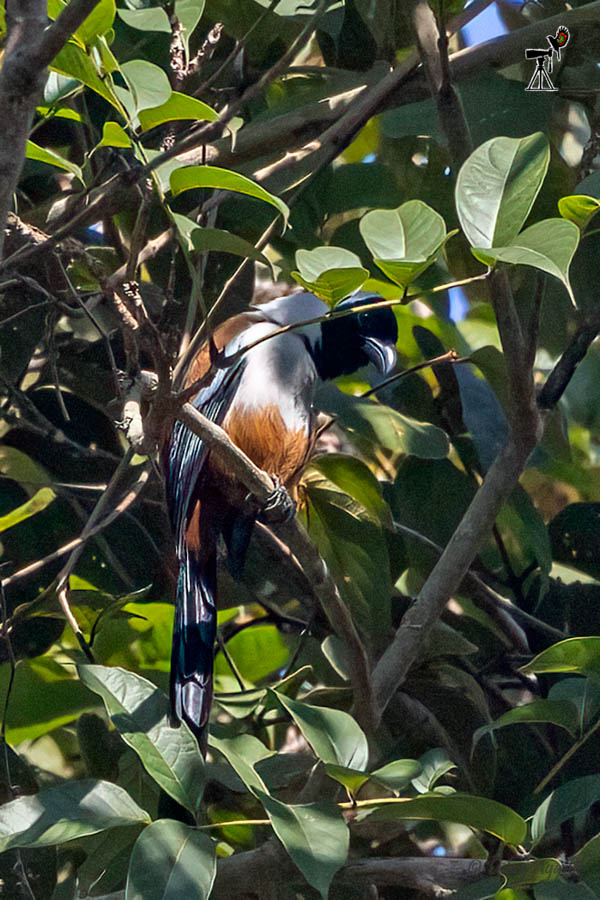
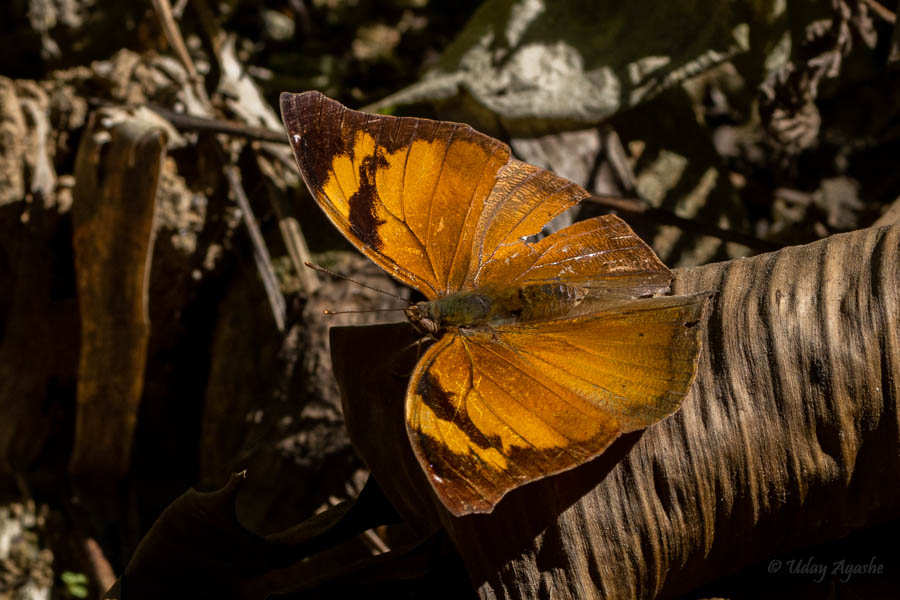

We continued our walk and quickly got in pursuit of another skulker, the Streaked Wren-Babbler. Its calls were so soothing and the bird was somewhere very close to us. All of us were looking through the clutter and every time there was some movement in the leaves, we got excited. The bird did not sit in one place for long (thankfully, the next day I managed to get a good photo). I am sharing a couple of photos here, just to give some idea of the habitat we were searching for.


Being a little tired, we covered some distance in the vehicles but the ride was too bumpy for any comfort. Soon we got down again as Palash had heard some calls from the valley below. He got all of us to stand in a single line and asked us to keep quiet. He had seen a flock of White-hooded Babblers and was sure that they will come close to us provided we remain silent and without any abrupt movement.
True to his words, the birds did come out in the open and this time they allowed everyone to take good photos.
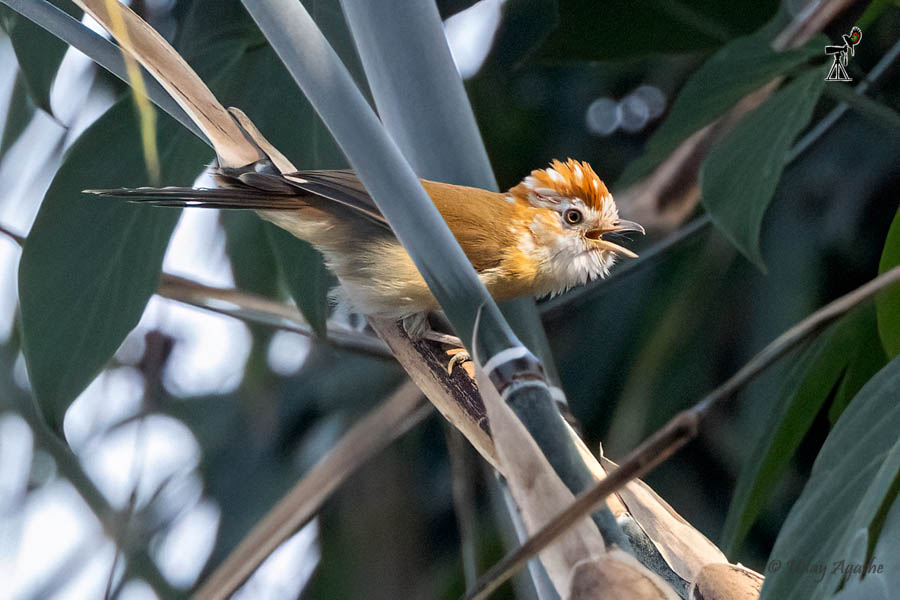
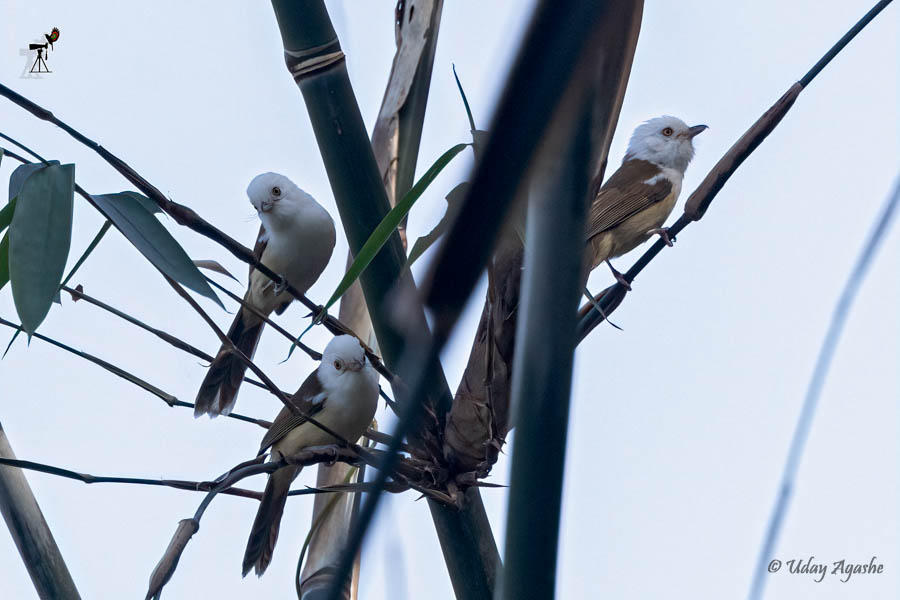
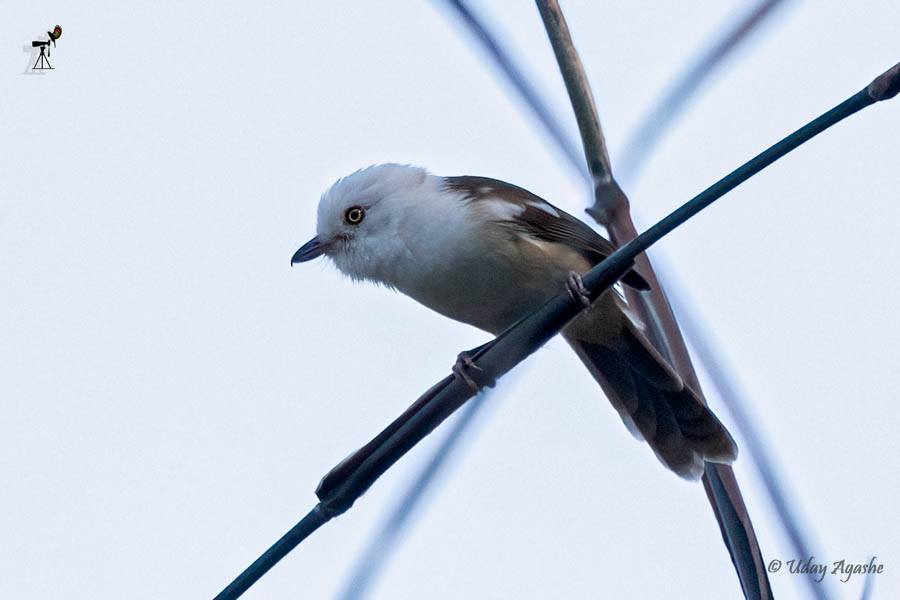
With all the walk, we were hungry by noon and decided to take a break for lunch. Found a decent place to park the vehicles, and opened our lunch boxes. The small waterfall there provided water for washing the spoons, and plates.

In general, most of the birding happens before noon and so after lunch, I did not expect too much birding. But here we kept seeing something or the other at regular intervals.
These jungles in Arunachal and Assam have the Hoolock Gibbons (type of monkey) in good numbers. But so far in my last 2 trips, I had only heard their loud calls (and these calls are really loud). That afternoon, Avinash sighted a black object behind the leaves, that was much larger than any bird. On closer look, we saw the Gibbon. It was well hidden in the clutter, plus its black color made it even more difficult to see in the dark surroundings. Most of the time, it was looking towards the valley but luckily I got the moment when it was looking at us. The white eyebrows of the male were very prominent.

As we walked ahead, we saw a few bulbuls and the sultan tit. All 3 birds had nice crests but each had its uniqueness.
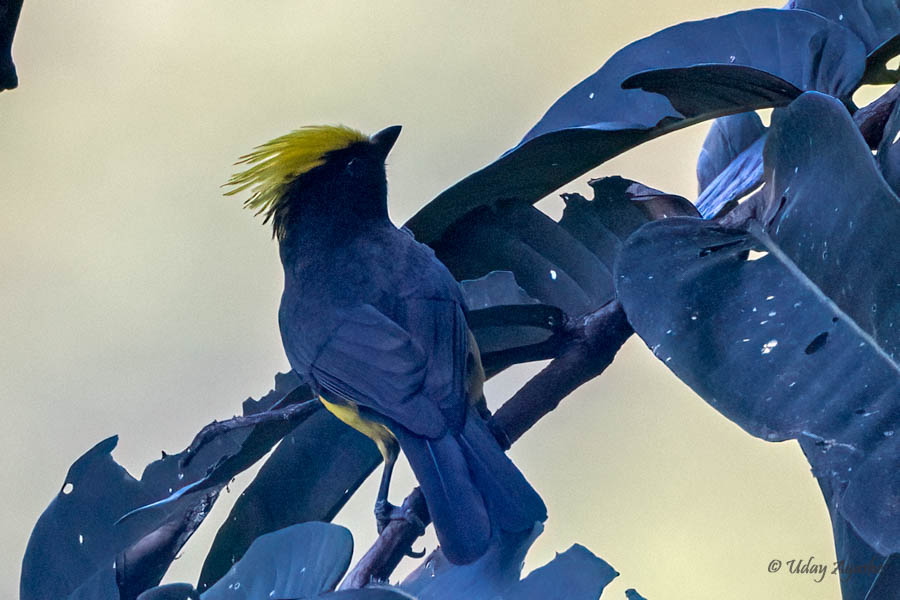


By 3:30, the light had started reducing and in this dense jungle, it was more so. We were now in the vehicles. Sometimes, being in the first vehicle has an advantage. On one of the turns, we saw one small black-and-white bird walking on the road. That was likely to be a forktail and they generally have a habit of walking on the path (if not disturbed). So Palash motioned us to get down and check the bird on foot (we were on a turn, and the bird was not visible from the vehicles). I slowly walked ahead to see the White-crowned Forktail. Quickly took a few photos as others joined. The bird flew but kept to the road and soon it was joined by another. We thought it was a pair, but then it was the Slaty-backed Forktail.


By now, we had covered a lot of distance but Palash had one more spot in mind, so we kept going ahead. He was aware of a tree that was frequented by a pair of Oriental Hobby. And they were there today too. But they looked so tiny on that tall tree, we had to look through the binoculars to believe it. Near or far, being lifer meant we had to take photos. Tried changing a few angles too (by walking a few meters ahead and behind, adjusting for light, adjusting for a clearer view, etc., etc.).
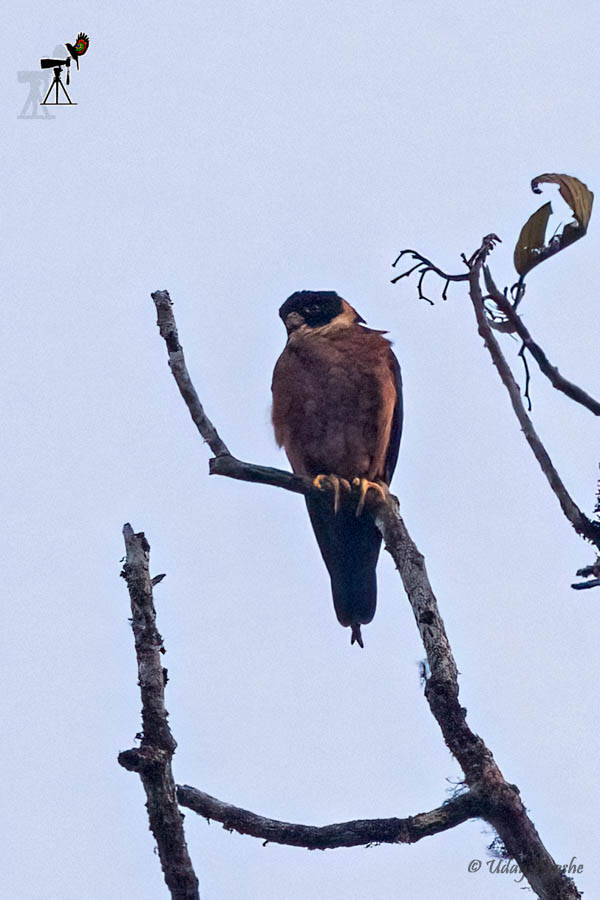
This was the last target for the day. I said “day”, meaning there were still some expected species for the night. And although the light was low, it was not dark. There was no point going to our Rest house and coming back, so we decided to wait at a watch tower that we had seen on our way some distance before.

From the tower, we had a nice view of the river below. After the group selfie, the oranges were out quickly, and with that, the feeling of hunger became prominent too. So out came all the snack items from sacks. Someone (most likely me) then thought about a nice cup of hot tea and Avinash came to the rescue. He had a feeling that one of our breakfast thermoses was not utilized. Our resourceful drivers then went back to the car and got the breakfast basket. Not just hot water, we even had some coffee sachet, milk powder, and sugar too!! Believe me, that coffee tasted heavenly!
We waited till it became dark and then were on the lookout for the owls. Besides owls, we were also looking for the Slow Loris. Every few 100 meters, we checked for owl calls and also scanned the nearby tree with powerful torches but even after spending an hour, we could not find anything. By then we were aware that tomorrow was going to be very hectic (on that watch tower, Clara had hinted to us that tomorrow we will not be having our vehicles with us and it will be a full day of a long walk in the jungle) so we decided to go to our resting place.
Near the forest guest house, we had to pass a gate guarded by Armymen. It seems there was some trouble caused by local tribes in the recent past and that resulted in this new army camp. For the next 2-3 days, we would be passing this gate regularly, so Palash had a word with the in charge there and explained the purpose of our visit. We were granted permission without any issues.
The Forest rest house looked like a good place. They had 3 rooms close to the dining hall and 2 rooms a little far. We quickly got into the allocated room. The rooms were decent and even had no electricity issues. Just as we expressed our happiness about it, we realized that the taps had no water!! The bathroom had 2 buckets of water but that’s it. No water in the flush tanks either.
At dinner, we raised the water issue and the caretaker assured us that it will be there by morning (at 4 am). The dinner menu was good. The usual Daal, Rice was well supported by Rotis.
After dinner, we had the customary checklist reviews (of the species seen/heard during the day). Oh, and although I have not mentioned it earlier, we did this exercise without fail, every day (even in Walong where we did it in torchlight).
After that Avinash and Clara reiterated that tomorrow, we will have to carry our breakfast, water, and snacks on our backs and we will be having a long walk. Thankfully, our drivers took the responsibility of carrying our lunch to the predefined destination. We would be returning only by evening, so essential medicines, spare camera batteries, and memory cards were also to be carried.
The Haldi bari Trail
Once again, we were ready to start by 5:30 after tea biscuits. Yesterday, we traveled on one side of the river, and today we were planning to go to the other bank. Here’s a map to give you some idea of our route.

We were at the Deban Forest Camp and we aimed to reach the Haldi Bari point mentioned on the map. This seems to be a popular path for trekkers. What we learned there was, there is a 5 days camp that takes them to the end point and back. They carry their own provisions as well as tents as there is nothing (other than the jungle) in that patch.
Up to Haldi Bari, it is only 5 km but we were assured that if we found it difficult, we can stop at whatever point in between.
As we began our journey thru Tall Grass, a thin bamboo bridge over the river, and then a bamboo staircase, we finally reach reached the base of the jungle trail.
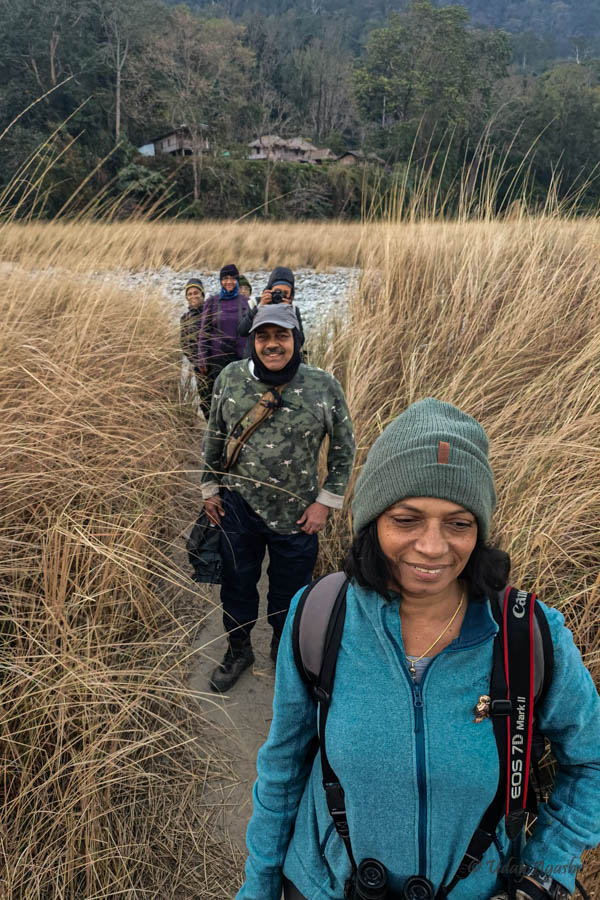
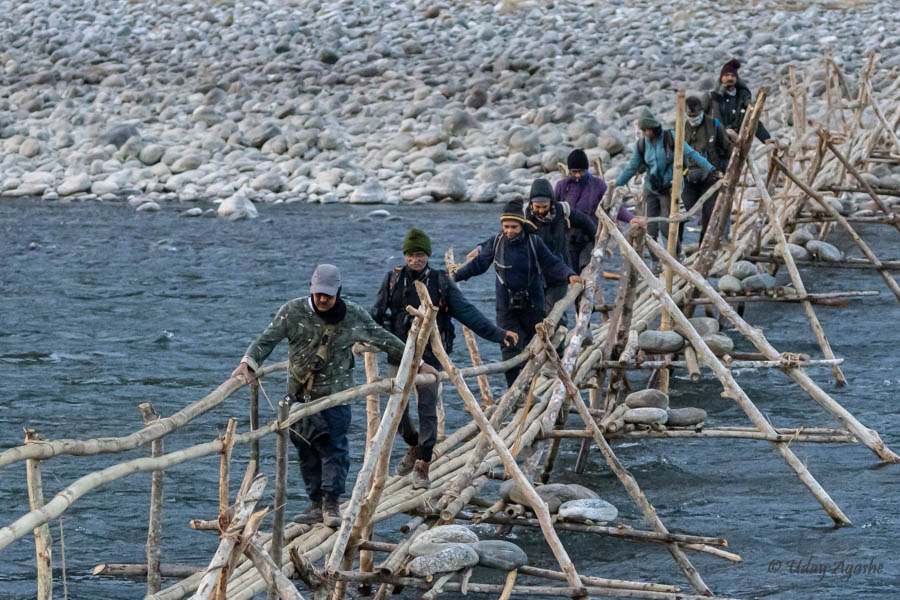

This side of the jungle was even thicker and much less disturbed by humans. We kept to the narrow pathway created by the trekkers (and occasional birders), crossing fallen trees (sometimes below the tree trunks, sometimes over them). Birding was one, but maneuvering these ups and down was going to be another challenge ahead.
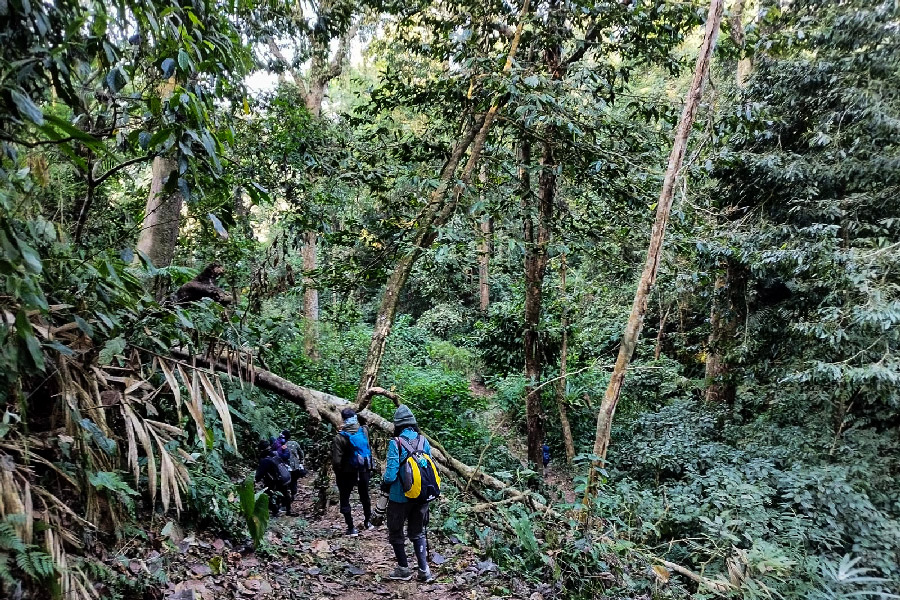
As we started the actual trail, we slowly started hearing the calls. Soon we were able to see the Yellow-bellied Fantail, Bronzed drongos, Streaked Spiderhunters, a mixed flock of Minivets, and yes, just as we were crossing the bamboo bridge, we saw a flock of about 8 Wreathed Hornbills flying across the horizon.
Most of the time, I ended up using just the binocular and hence no photos to accompany the text.
At about 8:30, we had our breakfast. It had to be on the jungle floor but Prasad offered his plastic poncho which we could use to lay our breakfast spread.

After breakfast, our fortunes improved a bit and we were able to get some photos of butterflies as well as birds. Prominent among them were Saffire Flycatcher and White-browed Shrike-Babbler (both lifers).

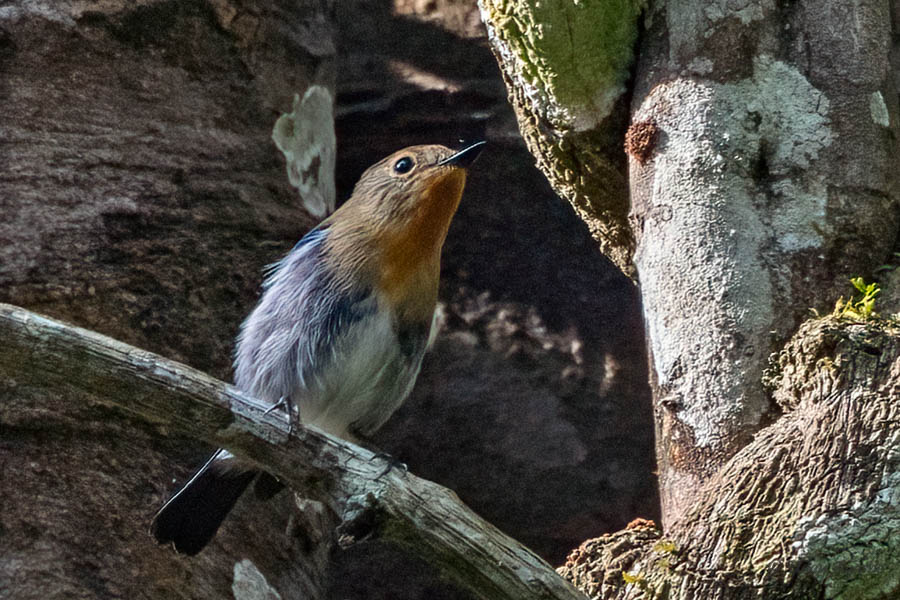
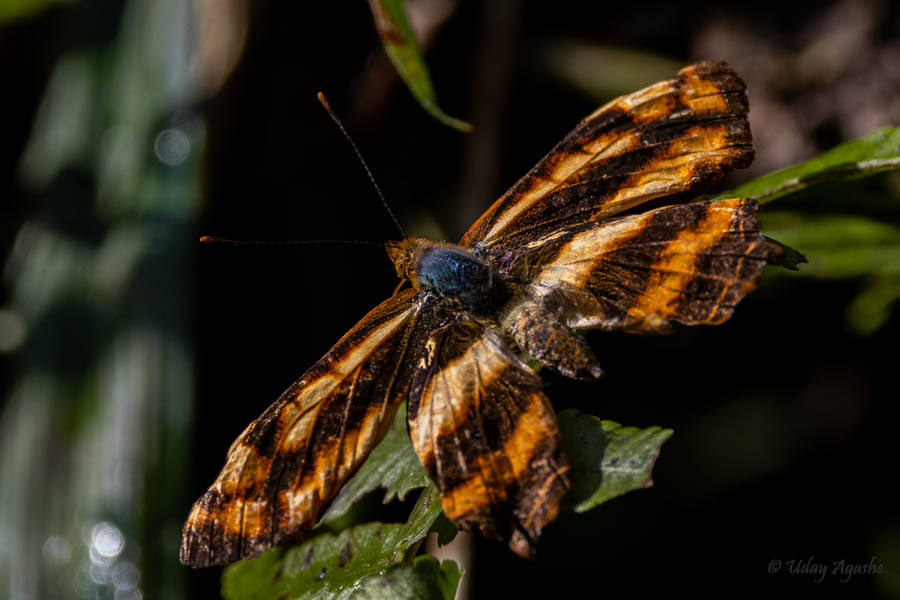
As we kept going, the trail at times became more difficult. There were some treacherous slopes and some steep gradients. We even had to cross small streams. The only good part was, we did not have any leach trouble.
Do you remember, I talked about the Streaked Wren-Babbler earlier? Here, we once again came across its calls. This time we did not have to wait long and the best part, the bird sat on a relatively open perch at eye level (and not far from us).

The Wreathed Hornbills were on our target since morning. Early morning, we had seen them fly, but they were way too far from us. We accidentally stumbled upon a tree that was home to many of them. Only problem was, the foliage was so dense, that we could hardly catch a glimpse of either their Eye or neck or just the tail portion (never full bird). And as we realized their presence above, they would naturally have sensed us below. Gradually they started flying (the flapping sound of their wings was mesmerizing).
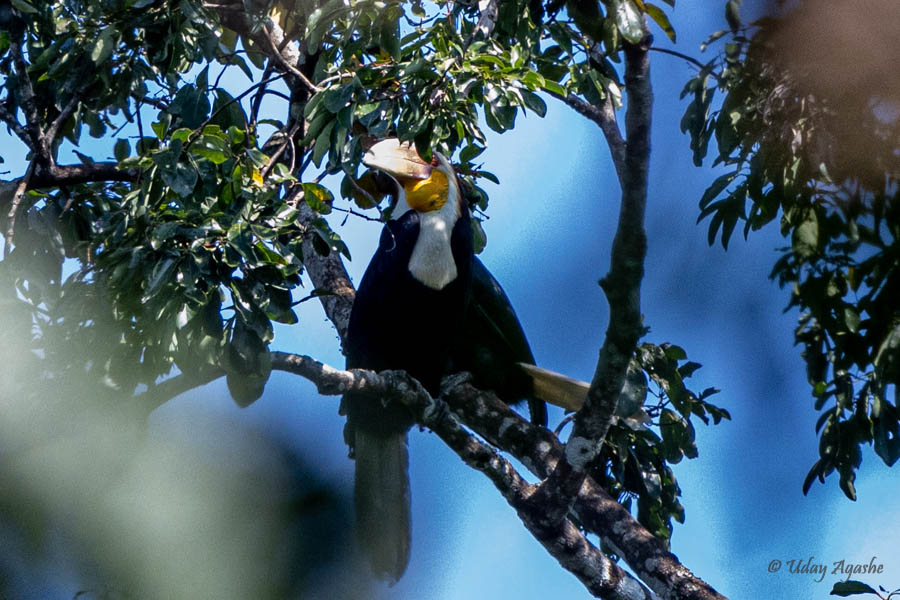
We kept going ahead without having any clue as to how much distance we have covered and how much more to go. There were no landmarks or milestones for reference. But by 12:30 we finally reached a spot where stood a wooden structure that could be used as some shelter. That indeed was the last point for us. We were all tired so the wooden floor of that structure felt very comfortable to relax. This is where we will be having our lunch as well. There was a stream nearby. The cold water was so refreshing.
After a little wait, our drivers arrived with the much-awaited food. We quickly sat down and enjoyed the simple meal of rice and egg curry (poor Prasad had to eat the rice with dry potato sabzi and some lemon juice).
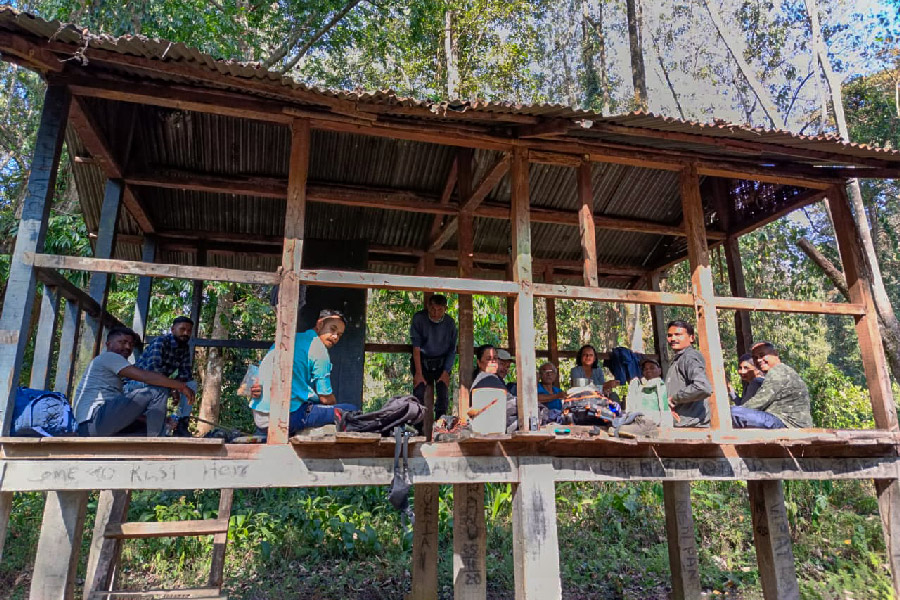
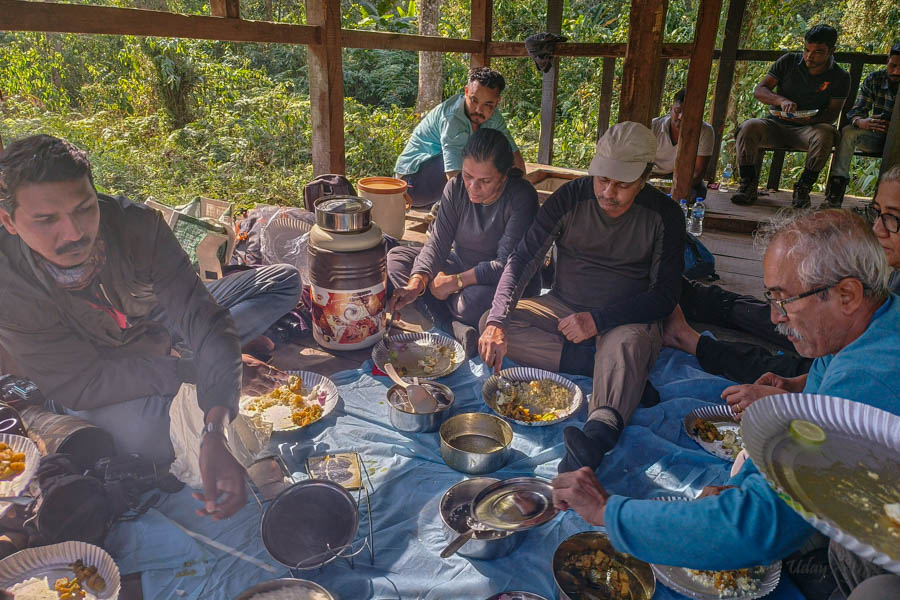
We had a 10-minute rest after lunch. Couldn’t wait anymore as we had to reach back to our rest house before dark. With that in mind, we all hurried through.
We did wait a few times for various birds but most of the time had to remain satisfied with watching them through binoculars. And by that time, we were so tired that while waiting for any bird to come out, we just sat on the forest floor instead of standing.
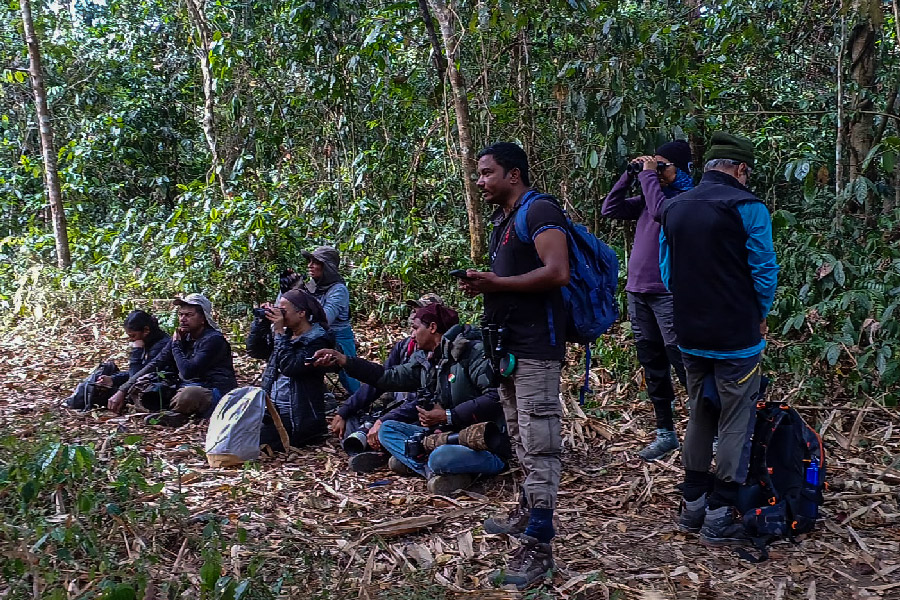
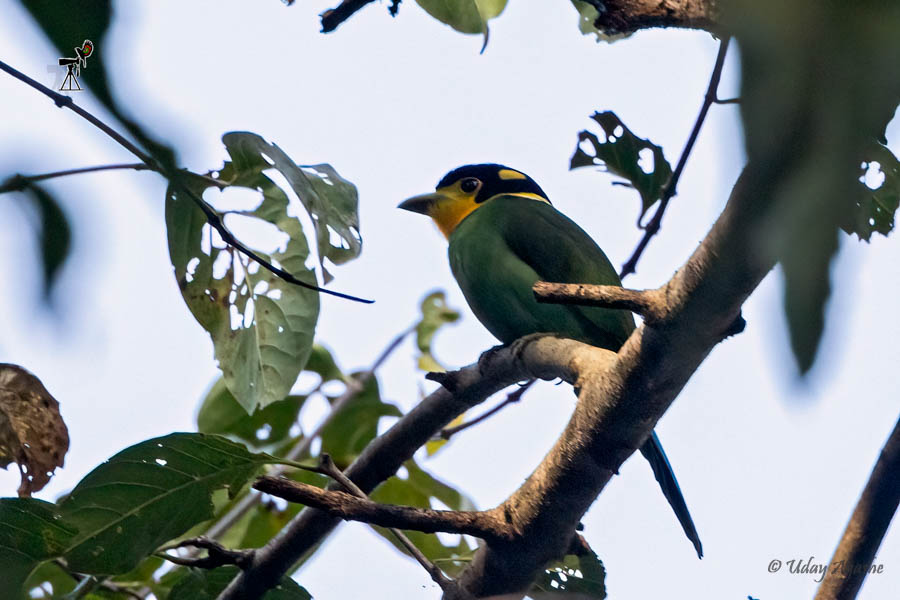
Our return journey suddenly became exciting at one point. At the beginning of the trip, Palash had warned about 2 mammals. First the wild buffaloes and second the wild elephants. If we were to come across any of these, the only option in front of us was to run fast (and try to remain in a single file, instead of scattering in all directions).
On one of the steep gradients, I got up the slope with a lot of effort. Avinash was ahead of me and Palash was just behind. Avinash asked me to wait as he had seen some movement ahead on the right-hand side. We could sense that it was not a bird, but some big animal must be causing the movement. Others were also reaching near us now and suddenly, the elephant trunk was seen. Out of fear, and excitement we all took an about-turn and were waiting for someone’s signal to run. Avinash even dropped his jacket (it was in his hands) while moving back (barely clutching his camera).
But before any further mishap, Palash (oh, by the way, he had not moved at all) stopped everyone. He clarified that this was a tamed elephant belonging to the forest department. Then we even saw a big chain attached to the elephant’s legs.
No more excitement beyond that, we carefully got down on the bamboo staircase and also crossed the river bridge. As we came into the open (from the deep jungle), we once again saw the flying hornbills, but this time we could at least take a photo.

After reaching Rest House, the first thing we enquired about was WATER!! No luck today either, they did not get the required water supply from the upstream pipeline and hence there was no possibility of having any tap water tomorrow. During the day, for some time they had water and at least the buckets were filled again.
With no luck with water, we thought of trying our owl-luck. It was getting dark anyway, so instead going back to the rooms, we had a quick tea break and started our trail again (this time, thankfully in the vehicles). We covered a couple of kilometers and then got down walking again. Palash sensed some movement in one of the tall trees and quickly directed the torch in that direction. It was the Red giant flying squirrel. The squirrel remained in that position for a couple of minutes, and we all managed to get the photos.
Little later, Palash spotted the Slow Loris. But there was a lot of confusion about the sighting. Some were saying there was 1 loris, some saw a pair, and few of us (including me) could not see even one.
We continued for some more time but unfortunately, we could only hear the owl's calls. None came out in the open.
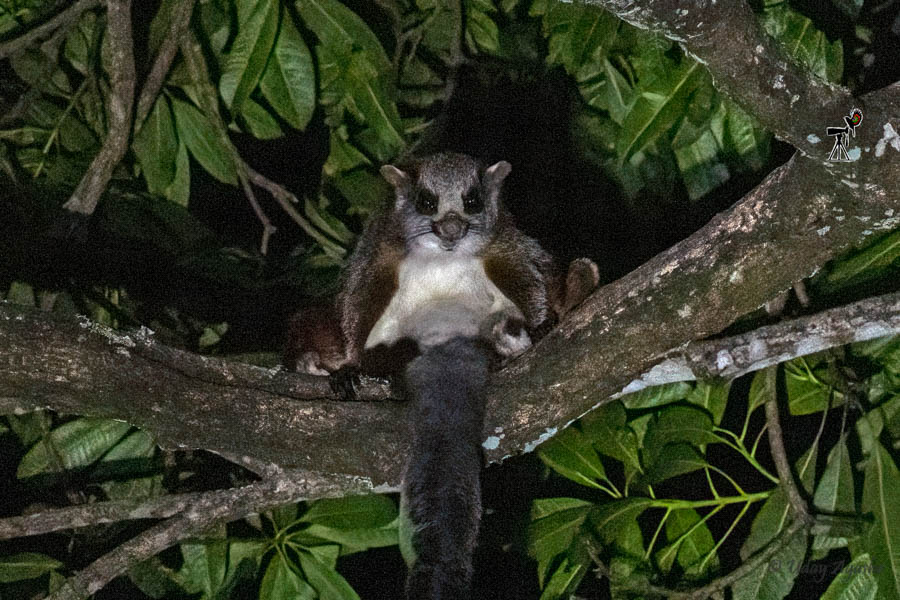
Day of Unexpected Photo Lifer (1-Feb)
We had our usual 5:30 start. The Plan was to do birding (again on the Vijaynahar road) till noon, come back to the rest-house, have lunch, and then head to our next destination, Maguri Beel.
As we got onto the trail road, we immediately sighted the Spotted forktail and soon a small flock of Mountain Imperial Pigeons.

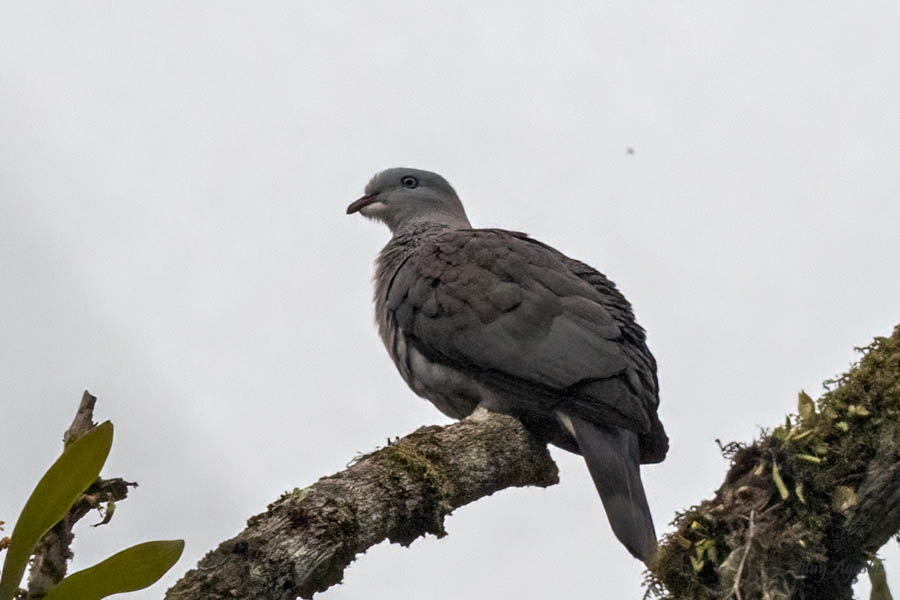
We then started walking as more bird calls/songs were heard. The Nepal Fulvetta, Long-tailed Sibias, Bulbuls, minivets, and even a Crested serpent Eagle were seen at regular intervals. But we spent more time on a flock of Grey-headed Parrotbills. Many of them were seen on a single tall tree but capturing them on the camera turned out to be an impossible task. With binoculars, I was able to see them occasionally but with the camera in hand, they were disappearing behind the leaves. Sharing a poor shot as that is what I could manage. Not just with this parrotbill, the next one, the Beautiful Nuthatch was even more difficult to get. On the field, I was so frustrated that I gave up after a few attempts. It was pure luck, that in some of the long shots, I was able to get a glimpse of the bird.
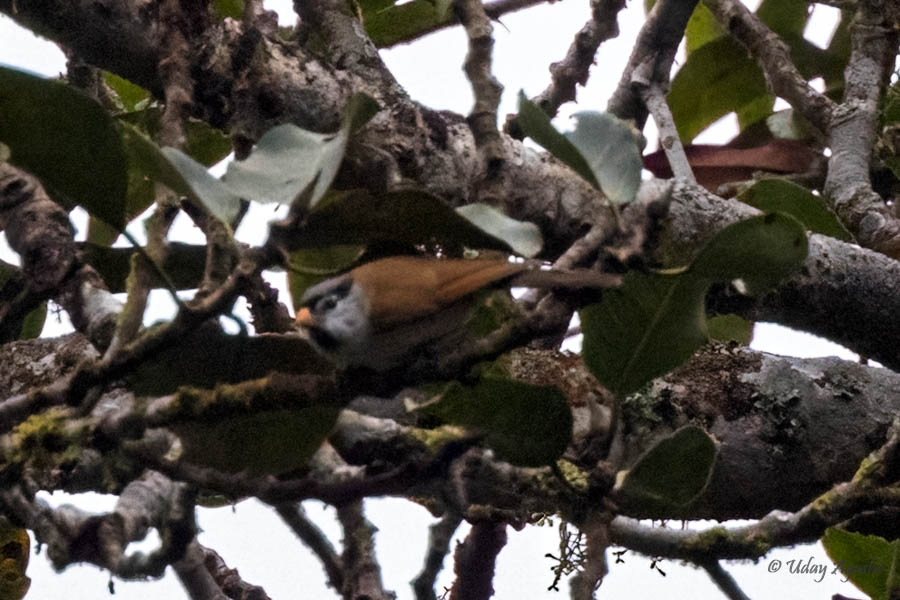
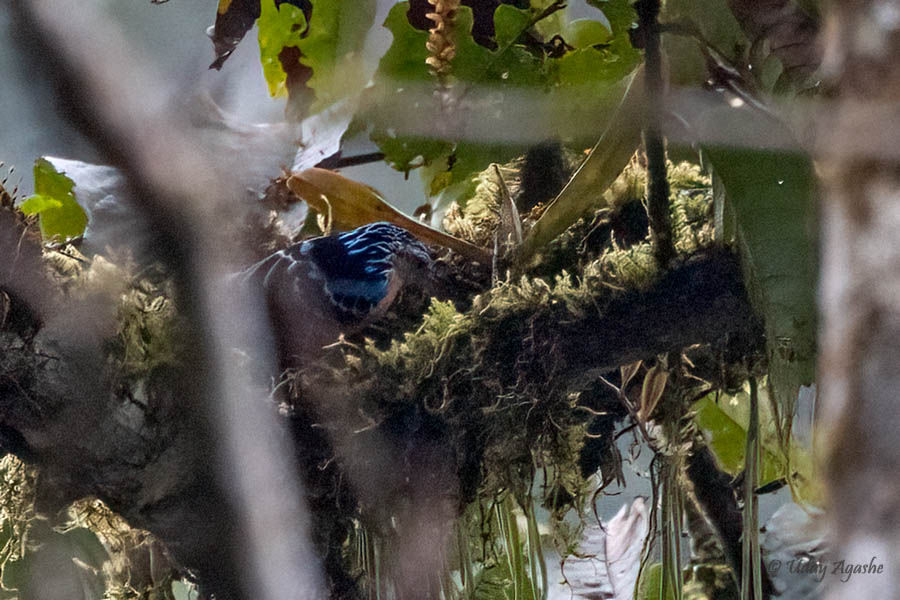
Just before breakfast, our hearts started beating rapidly with the news Palash brought in. He had earlier mentioned that a rare bird is sometimes seen on this trail near a stream. Just before that spot, he got down and walked alone. Within a few minutes, he was back and announced that the Blyth’s kingfisher was indeed there!
He asked us to follow him very slowly and pointed at a far corner. On the stone, we could hardly see it … boom… it flew! I was really desperate to get at least a record shot. I had missed it last year in Pakke as well (that trip was solely for Blyth’s and we had only seen it in flight once.. no photo).
So some of us moved ahead a few meters in search of its possible new perch. Just then we heard some hush-hush voices. Avinash was frantically calling us back. He had seen the bird again on another stone. We hurried back and managed to get a photo!! The bird was way too far for any meaningful photo, but now I at least have something to show for my efforts!

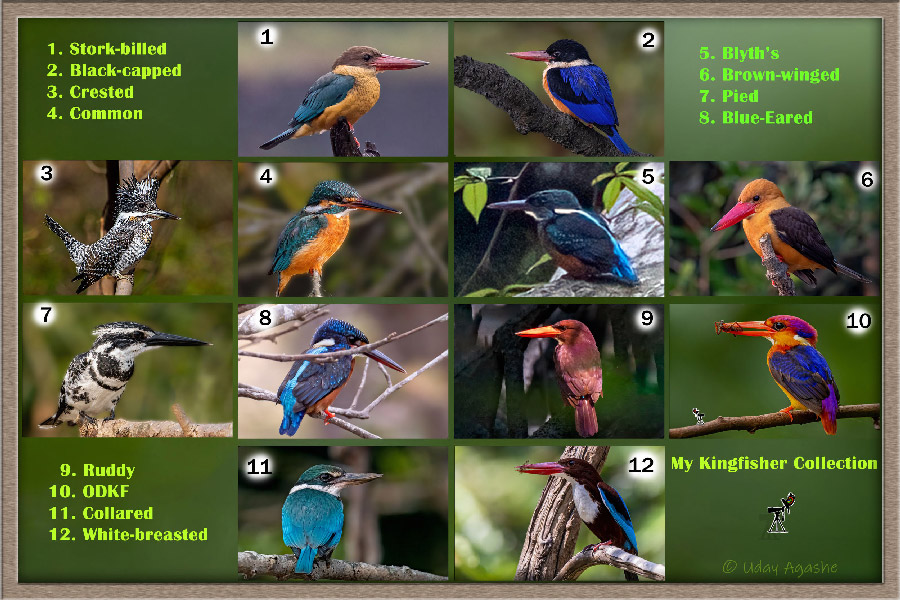
After that, breakfast was just a formality and so was the remaining trail till our Rest House. Not to forget, we did see a group of beautiful-looking day-flying moths.
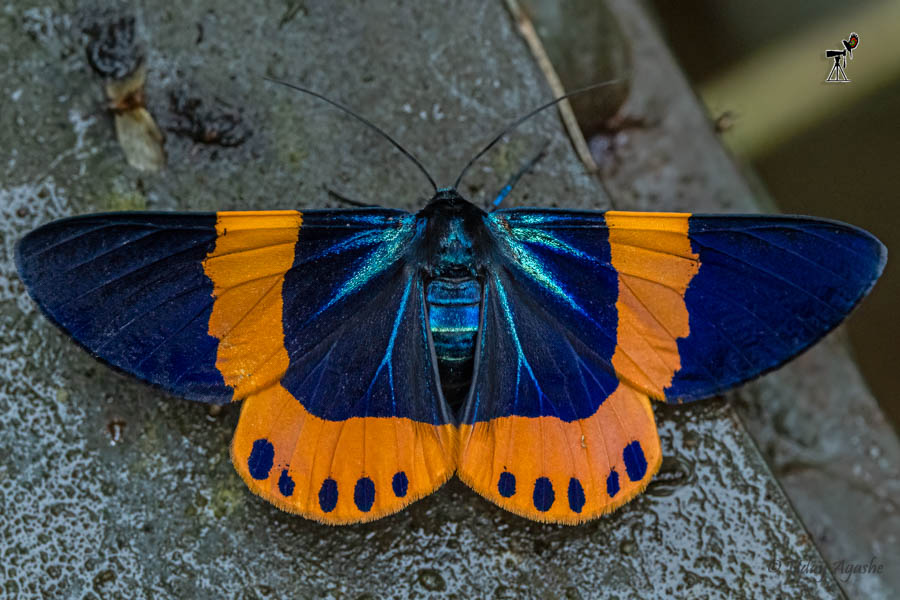
We were back by noon as planned for lunch. Quickly packed the bags and were on our way by 1:30 pm. But Namdapha had a few more birds waiting for us. On the way back, we managed to see the cutest (and probably smallest) raptor, the Pied Falconet. Far from us in the valley, the falconet was nicely perched on a broken tree. Then came the Rufous-necked Hornbills. We were almost near the entry gate on the flat grounds, when Avinash informed us on the walkie-talkie to look to our left. We reversed back about 100 meters to catch the glimpse of the hornbills.
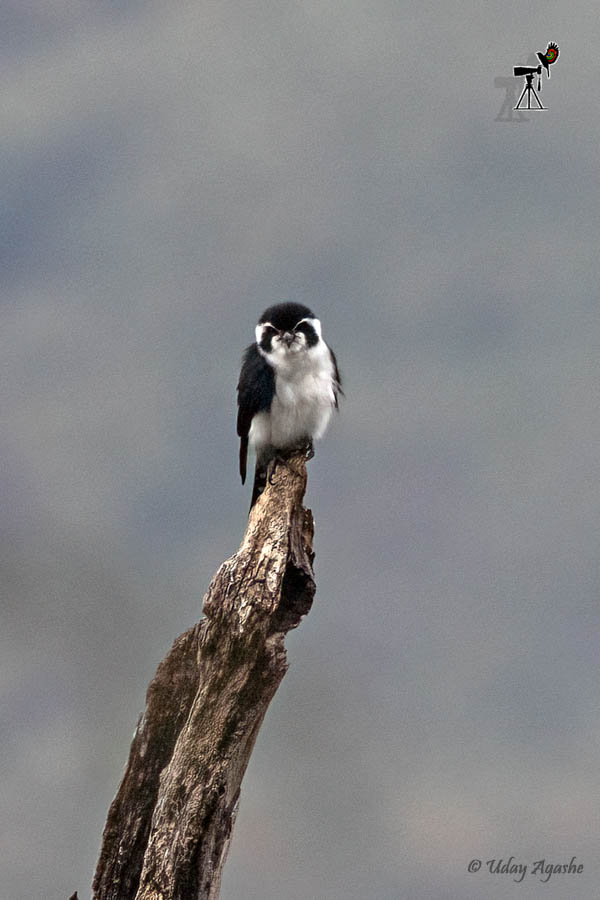
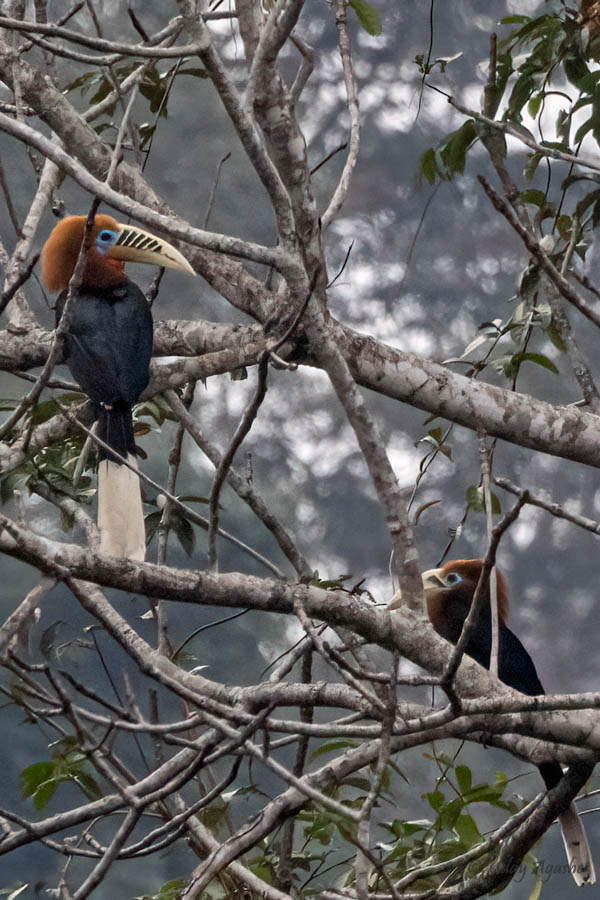
Our journey ahead till we reached Tinsukia town was very peaceful. The roads were good and there wasn’t any traffic either. The hotel in Tinsukia was 3-Star property. So much better compared to what we had stayed so far. We could have a nice shower (with hot water); the rooms were nicely lit and had air conditioners too (and electricity 😜).
Maguri Grasslands & More Lifers
Our plan today was to cover the grasslands in Maguri, an area called Koliapani. We had to take a small boat ride to these grasslands. We started our usual time 5:30 but we were 2 members short (because of a certain family emergency, they had to return to Mumbai).
After the difficult forest birding in Walong & Nmdapha, I was expecting better photography here but to our utter dismay, the morning was completely foggy. And the fog did not clear up to 11 am that day!
Today we planned to see a few rare species like the Reed Bunting (it was recently seen in this area), and White-tailed Stonechat. And to access this habitat, we had to cross the river. Palash had made all the required arrangements to perfection (after all, it was his home turf… he was born and brought up in this region). By the time our vehicles reached the riverfront, the boats were ready. These boats were very small and could carry only 2 persons at a time, so they had to do multiple rounds taking all 9 of us there.
Not sure how deep the water was, but we were instructed not to make abrupt movements or keep hands/legs in a specific position to keep the boat in balance. The other end of the river was visible because of fog, but the distance wasn’t much and soon we all were on the other side.
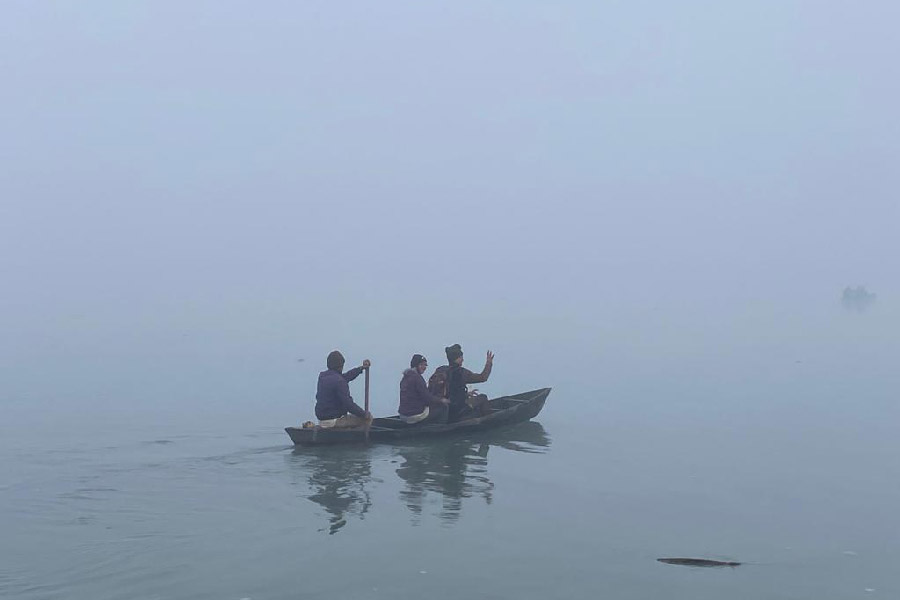
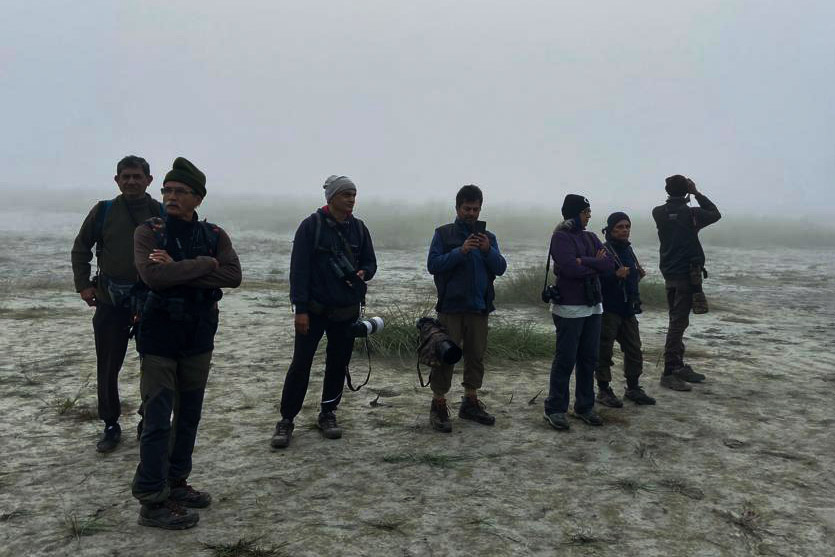
Walking on the sand is a little tricky, it is difficult to walk fast for lack of good grip. We walked thru the sands as well as tall grass to a certain habitat that Palash knew was good for birding (frankly, nothing much was visible so we just followed Palash blindly).
With low visibility, we were hardly able to see the birds and when seen, the colors were not coming well in the photos. But we still managed to capture the White-tailed Stonechat. The Siberian stonechat, Jerdon’s babbler, and the Yellow-bellied Prinia were also seen relatively easily.
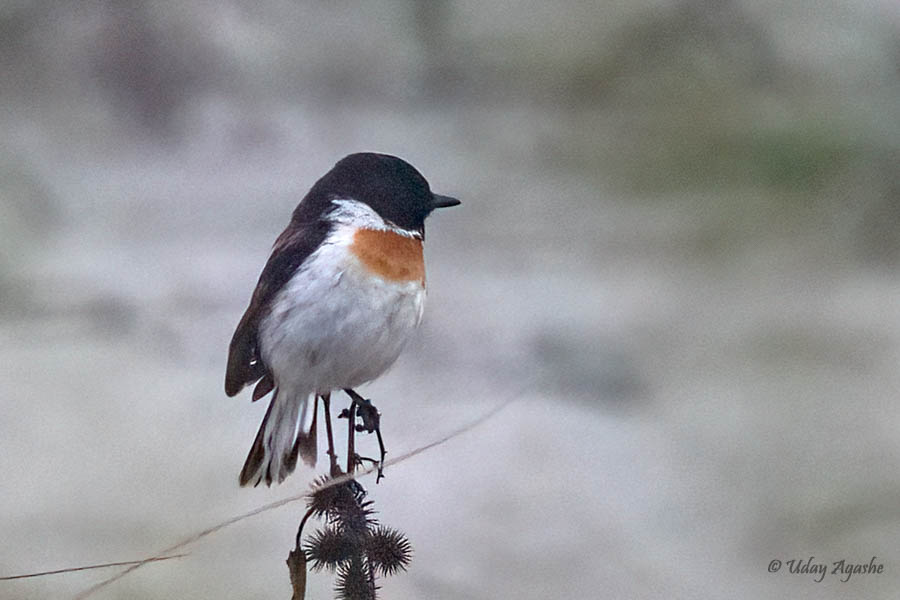

We were desperately waiting for the Sunlight but more so for the Reed Bunting. A rare one and not many records from India. But Palash had seen a few of them this season and we covered a lot of ground (grass and sand actually) searching for them everywhere. At one point, we came across these Bunrings as they flew across us but that was for a fraction and a second and with the low light, nobody was sure about the ID. We went in the direction of their flight and searched the region with binocs but nothing.
As we were on the lookout, Palash grabbed our attention and asked us to take a photo of one different-looking bird. Without wasting time, we grabbed the opportunity to capture another lifer. It was the Golden-headed Cisticola. Little later, we saw a raptor circling above us in a typical harrier fashion. It turned out to be the female of Hen Harrier.


We initially thought of returning to the mainland by 9:30 but everyone agreed to delay breakfast and continue our search for the bunting. Our patience finally paid off when Avinash spotted a pair of Reed Buntings foraging on the sands. A few Sand Larks were also seen nearby, but Avinash reconfirmed the ID by carefully looking through his binoculars.

By about 11:15, we had our breakfast at Palash’s homestay. It is under construction, but the small dining hall is ready along with the kitchen. After late breakfast, we headed straight for the waters. We planned to cover the Maguri Beel (which means lake in the local language) by boat. It was late and by now the Sun was completely out too. In the afternoon, most of the ducks would be resting but we had no choice.

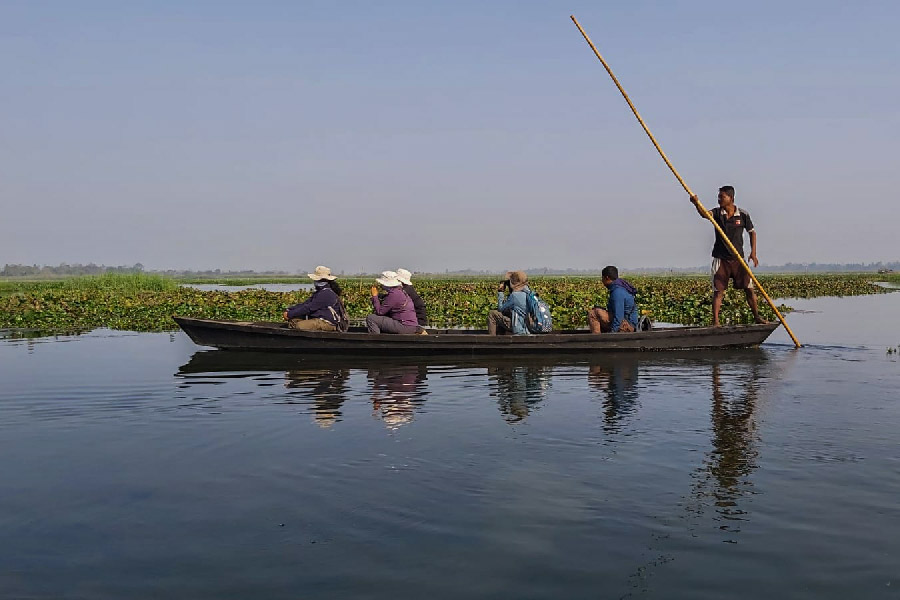
We got split into 2 boats (these are narrow boats used by the local fishermen but it gives a nice eye-level angle for photography). As we entered the waters, we immediately saw the Rosy Pipit and Striated Grassbirds. A few wagtails were also seen very close to our boats. As we entered the main water area, we could see a huge number of Ruddy Shelducks (I have never seen so many of them together).

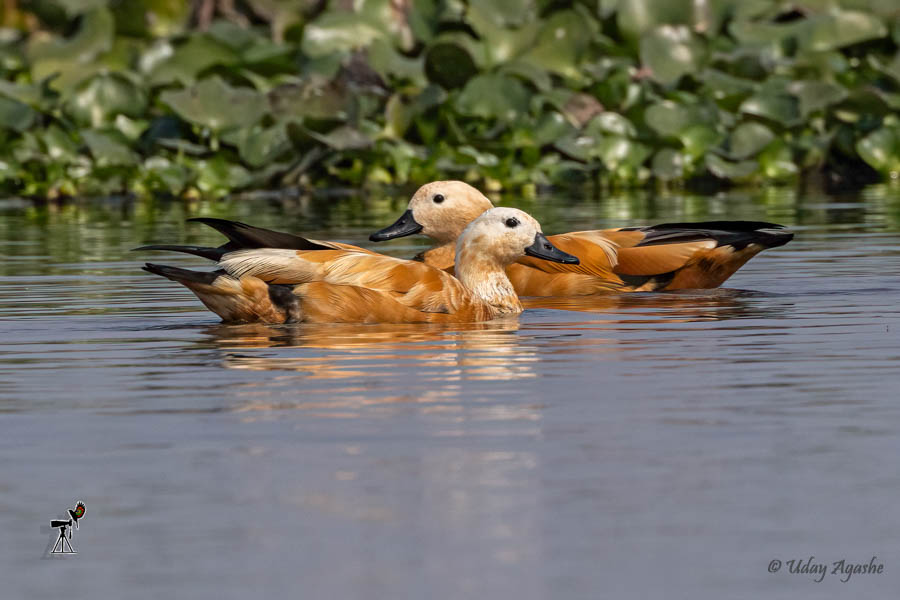
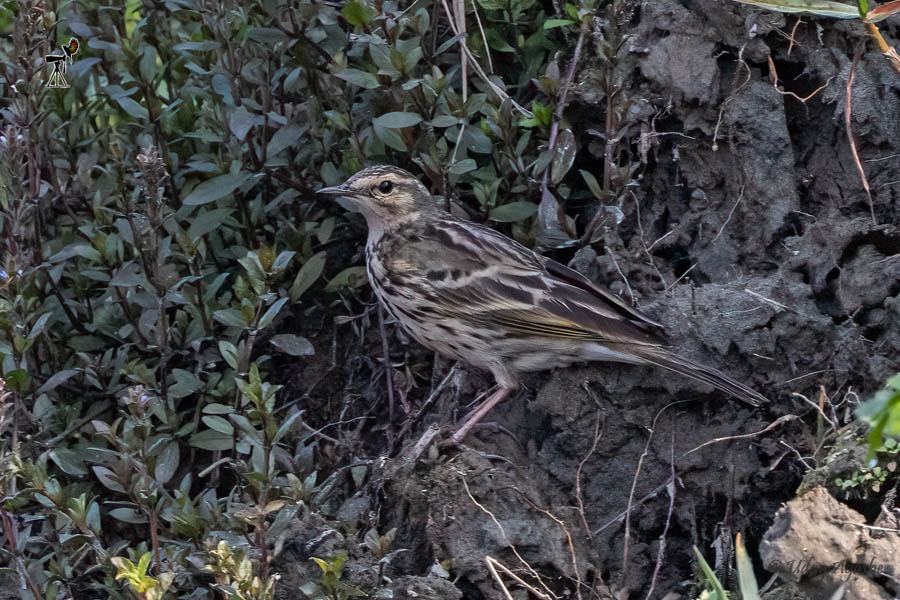
Soon we started seeing the other ducks as well. There were Euraisn wigeon, Red-crested and Ferruginous pochards, Northern Shovelers, and Northern Pintails, but what got our attention most was a lone Northern Lapwing. It was very far and we really struggled to locate it. And it was against light, so not good from a photography point of view, but we were all able to see it.
At one point, we got down onto a small island. This lake is spread over a long area and a lot of it is covered by Water Hyacinth. As the water is not too deep, a few small islands could also be seen. After getting there, we were able to spot the Bar-headed, and Greylag Geese. And soon we accidentally found a large flock of Northern Lapwings. A harrier was seen nearby, and that visit resulted in many of the waders flying away. Here, we could see the lapwings in flight.
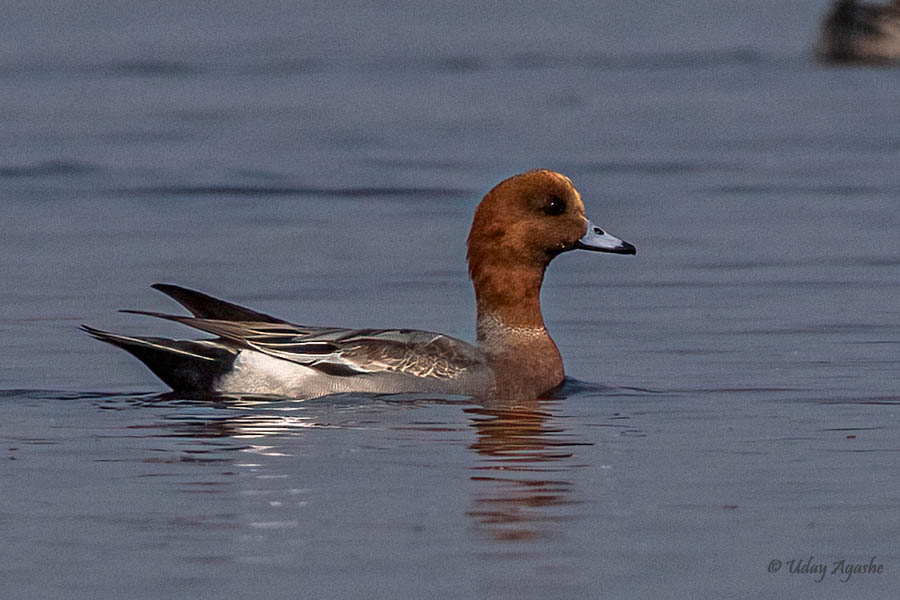
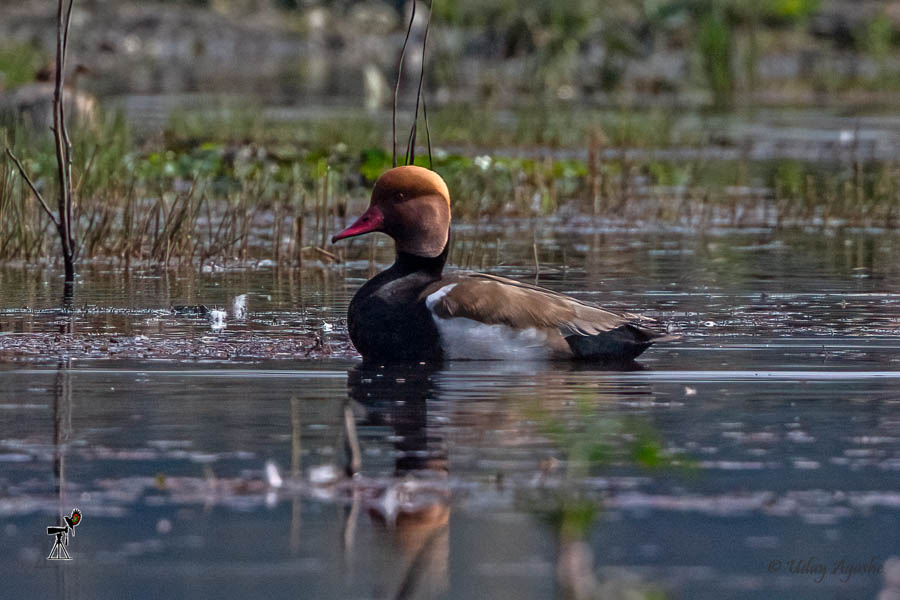
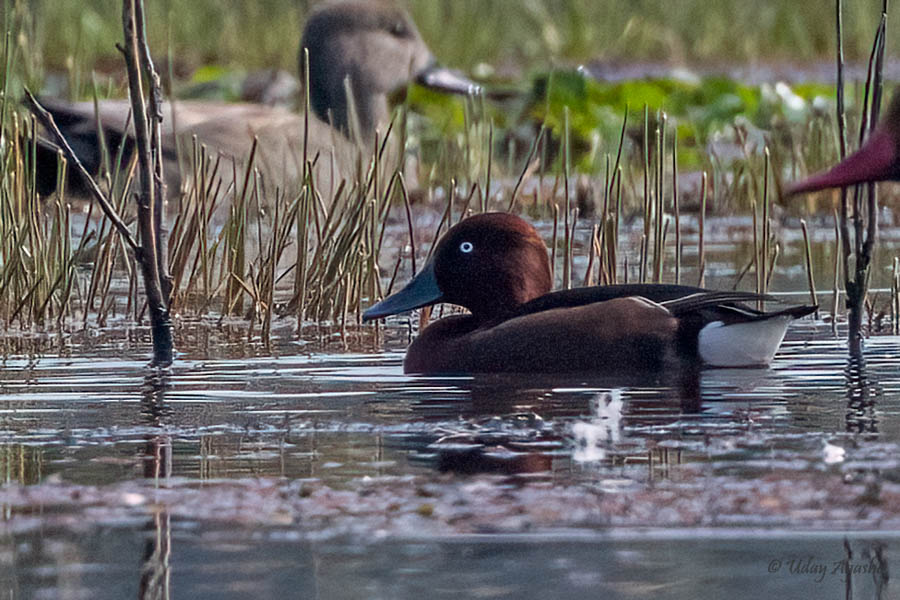
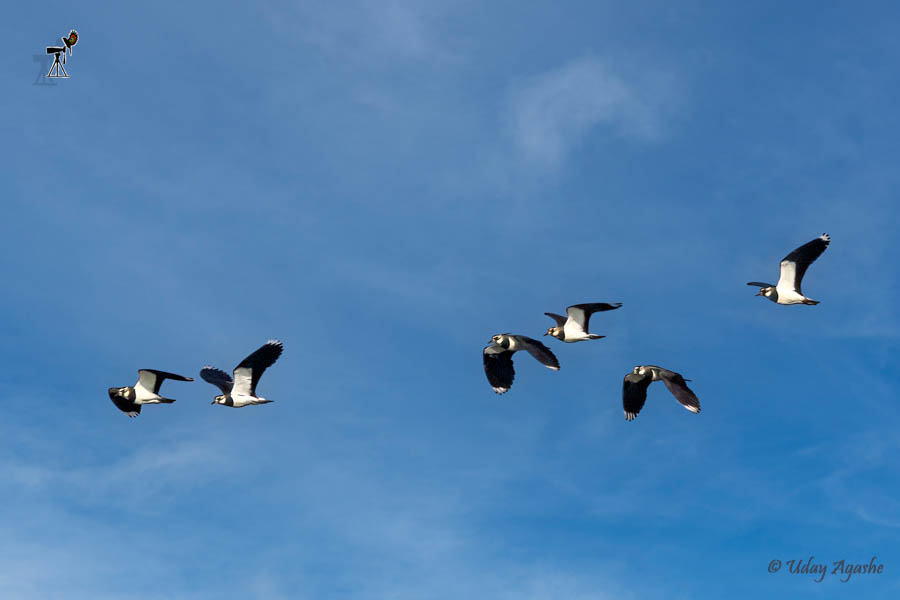
By 2 pm, we came out of the waters and headed straight for lunch (once again at Palash’s place). We would have preferred to have a relaxed lunch here but as you know the light here drops by 4:30/5 and we still had to cover a part of the grassland before ending the day.
We were a little tired when we started the trail again at 3:15 but soon the smile was back on our faces. Palash knew an area that was frequented by a pair of Brown-cheeked Rails. We walked to that part of the marshes slowly (Palash ahead and we followed in a disciplined line). He took a circuitous route to avoid being seen by the bird and made us stand behind the tall reeds. Through the grass blades, we could see the bird slowly coming out in the open, making quick foraging attempts and moving back into the bushes. This routine continued for some time, and in the process allowed us some good photos.
From there, we went to another grassland area similar to our morning trail but the water level here was not deep, and we could just walk through it. In the tall grass, we first heard the calls of the Black-breasted Parrotbill. And soon the bird came in the open too. Here, Avinash could also hear the calls of Chestnut-capped Babbler but I found it a little difficult to take photos.
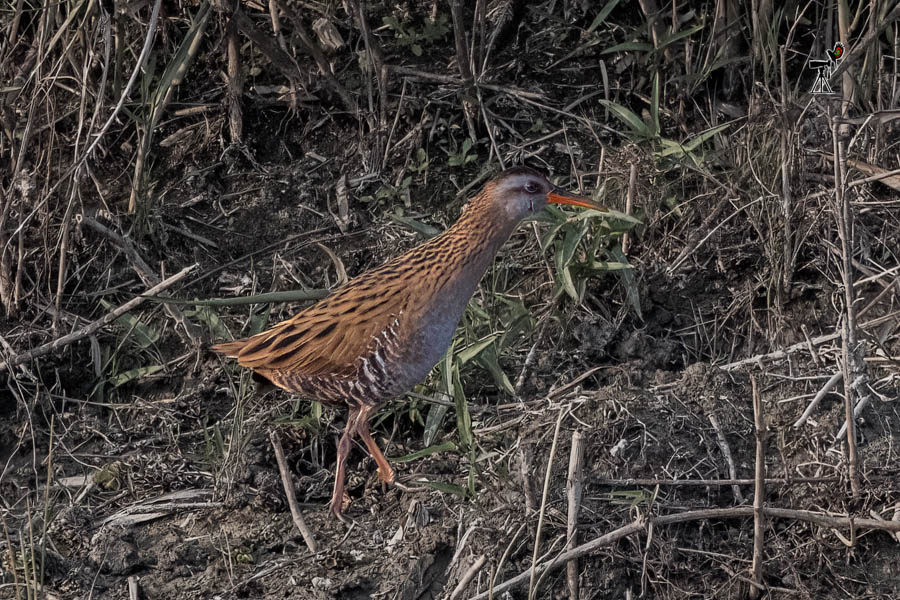
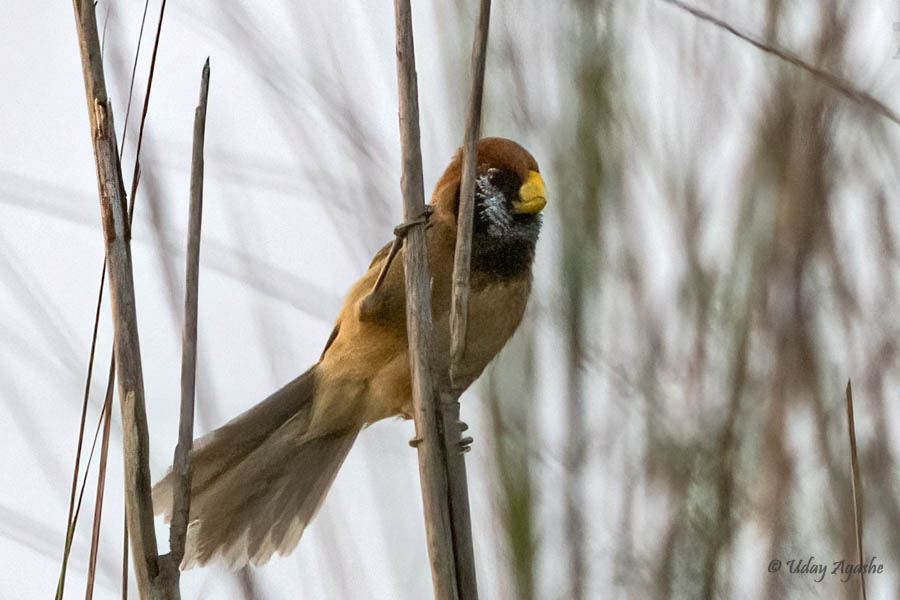
By now, the light was low but we still went a little ahead as there were a few bird calls heard. We did see the Yellow-breasted Bunting behind the reeds but was difficult to take a snap in that low light. By the time we were back to our vehicles, it was dark. But our day was still not over. From there we went in search of the owls. We did not go any far but kept ourselves to the village area and the tea estate nearby. Without much trouble, we could get the 2 owls and that finally closed another long day of birding.

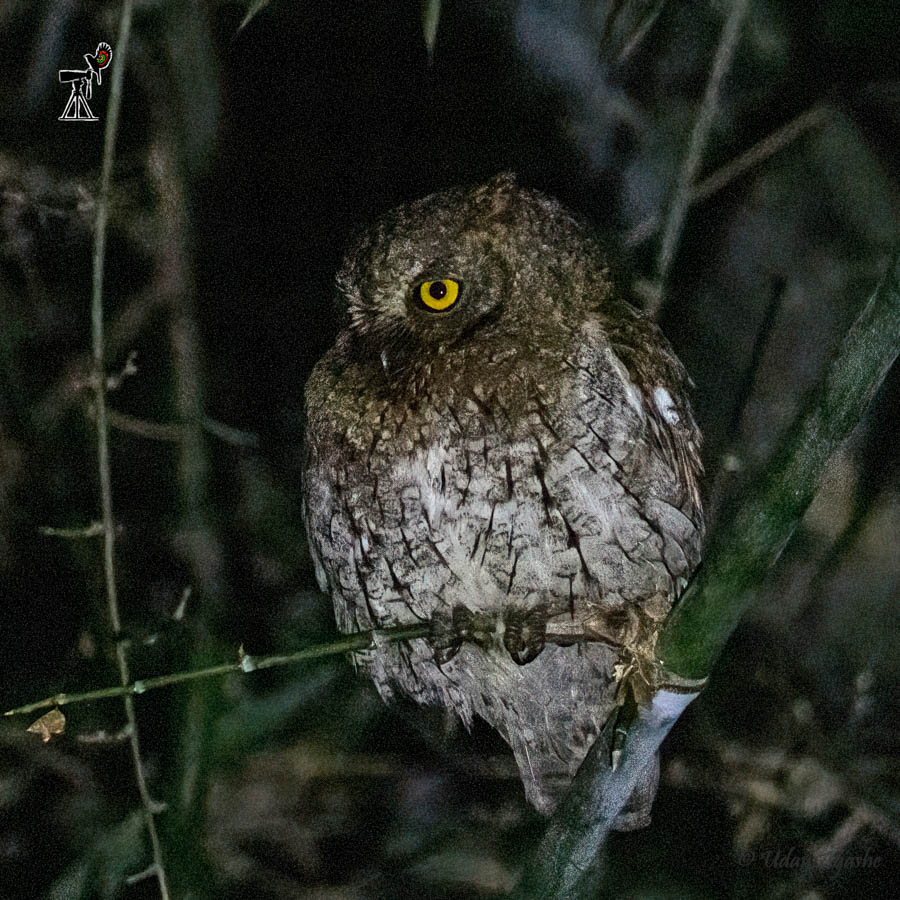
Final Day of Birding
We started a little late today as there was not much travel involved. Unfortunately, the fog was there even today. We went to the same stretch of grassland (close to the main road) where we had seen the rail yesterday.
We were greeted by a few Chestnut-capped Babblers and then we saw a lot of Red-vented bulbuls (must be 100 at least) that came out from the grasses and flew towards the water. As our eyes were getting settled to watch through the fog, Palash showed us the Smoky Warbler.
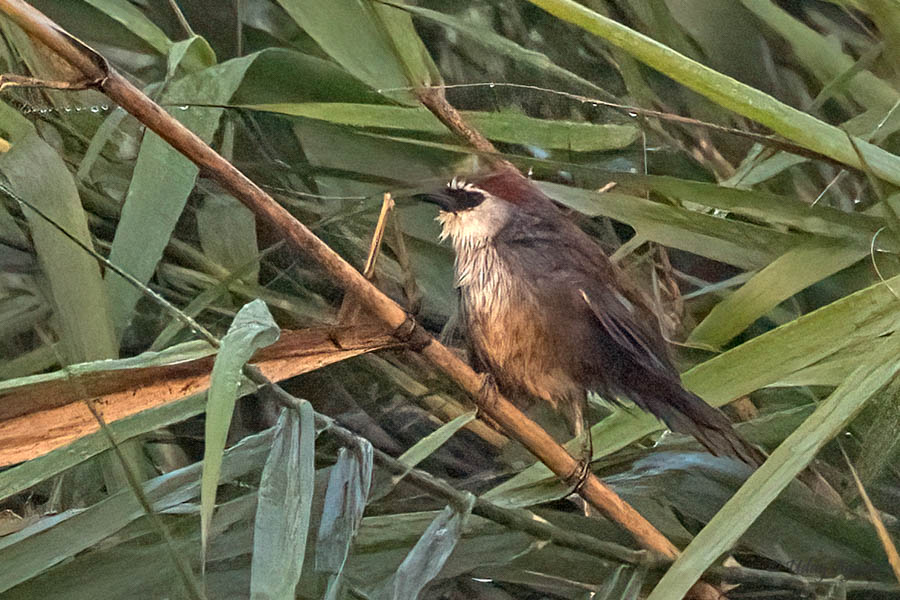
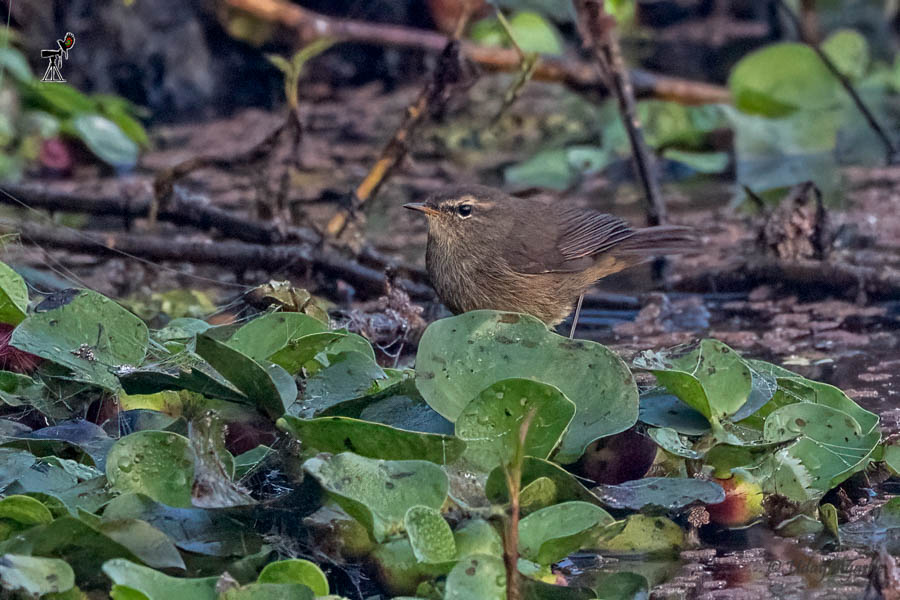
We looked for a few more bird species. A Swamp francolin was heard there but it did not come out at all. We now had 2 options, either to go to the lake again or try and scan the Tea estate. Palash was inclined towards the estate as he had seen 50+ species there during his last trip, so we went there first.
It turned out to be a nice birding spot as we kept seeing the White-rumped Shama, drongos, Snowy-browed Flycatcher, Rufous-bellied Niltava, Rufous treepie, Tickell’s leaf-warbler, the Whistler’s warbler, and so on. One hour of birding here resulted in a few lifers too.
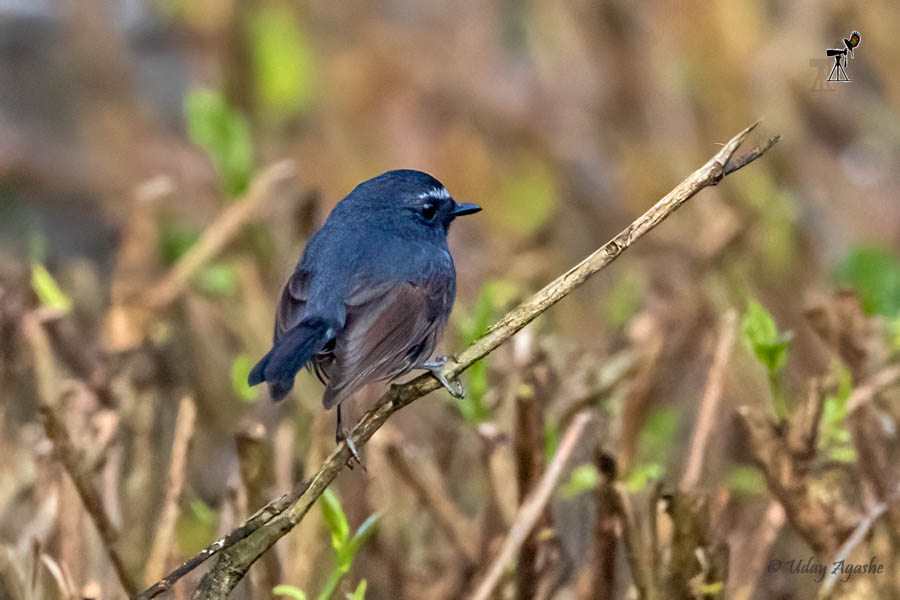

We still had some time so we decided to go for a quick boat ride. Plan was to do a boat ride till 10, have breakfast, go to the hotel, get ready, and start for the Airport by noon.
As we went to the waters, the usual set of ducks and other birds was seen regularly. A flock of Fulvous-whistling ducks then flew ahead of us (against the light). And we managed to get a better photo of the Northern Lapwing. But we could not find the Falcated Duck even today.
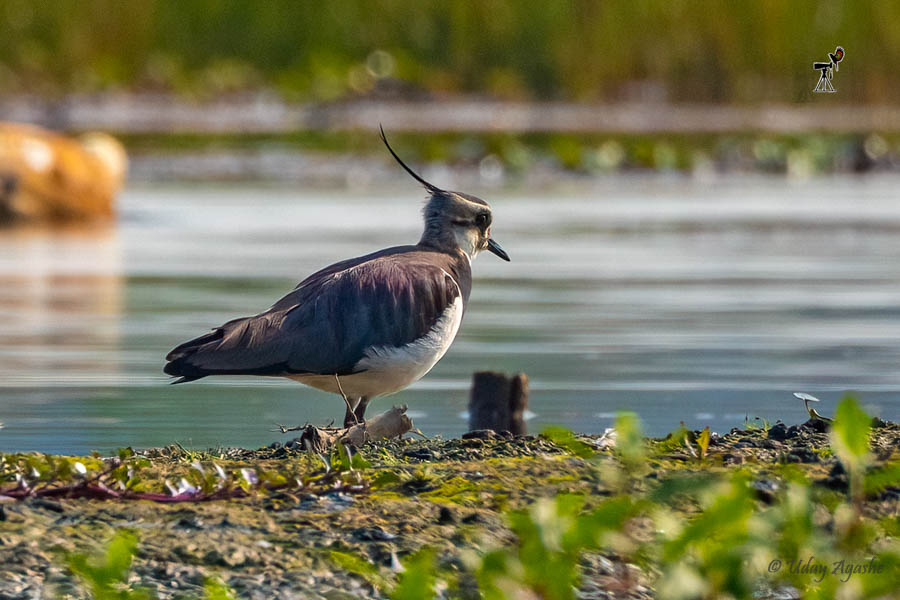
Our return journey became more exciting. As we had come a long way by boat, Palash thought smartly and suggested the boatmen drop us at a different field (the idea was we could walk a few meters to the main road and call our vehicles there). We did that and as we started walking Palash heard a different call and we got the jackpot sighting of the Scarlet-backed Flowerpecker. No, but this was not the excitement I was talking about.
As we walked towards the road (a narrow pathway built from mud, and sand) we saw our vehicles coming from the other side. But at one point, for a stretch of about 20 meters, there was no road. Just flowing water and a small fishing boat on the side.
The water was deep, so we could not even walk across. Palash then got innovative, since the boat was already there, he took us across to the other one by one (just enough space to carry 1 person). There were no oars with the boat, so he just used his hands and managed to take us across.
What was thought as a smart move, ended up taking more time plus Palash must have got really tired by the herculean efforts in getting us across.

From then onwards, it should be a smooth journey. We had breakfast at Palash’s place. A few group photos there and then headed for our hotel. Our flight to Delhi was on time too.


But our story doesn’t end here. At Delhi Airport, we got onto the bus that was taking us to the flight and there was saw some people coming out of the plane and boarding a bus. At first, we thought the incoming flight was still getting emptied and we must have come a little early. But as we entered inside, we got the confusion. By mistake, the Airline had stopped a Bengalore-bound crowd at his plane, and the poor guys got into the flight too. Soon the confusion was cleared, our cabin bags were verified, and all boarding passes were rechecked. This caused a few minutes delay but we were on our way.
As the flight took us, in about 10 minutes, there was an announcement calling for a doctor as one of the passengers was not feeling well. It was 11 pm and we all were sleepy. Then came another announcement “the doctor suggested the patient be taken to Hospital at the earliest”. With that complication, the pilot decided to route our flight to the nearest available Airport, which was Ahmedabad.
After getting down to Ahmedabad, an ambulance was kept ready and the patient was rushed out. That happened quickly but there were no signs of our flight taking off. The airline even provided complimentary snacks. After an hour, the pilot finally explained the situation.
The last scheduled flight from Ahmedabad had left by 11 pm and the airport was sort of closed. There were no refueling trucks available. An emergency landing and takeoff meant we were short of fuel. So the trucks were then called as an emergency and that caused the delay.
Finally, they arrived and we were again airborne. The good part was the patient was doing well (conveyed to us by the pilots) and despite all these troubles, we were only delayed by a couple of hours.
The long trip has come to an end here making me rich by 46 lifers!!
Hope you liked the loooong write-up.
Please note: Although all the bird photos are my own; some of the group, and other photos are by fellow participants on this trip.